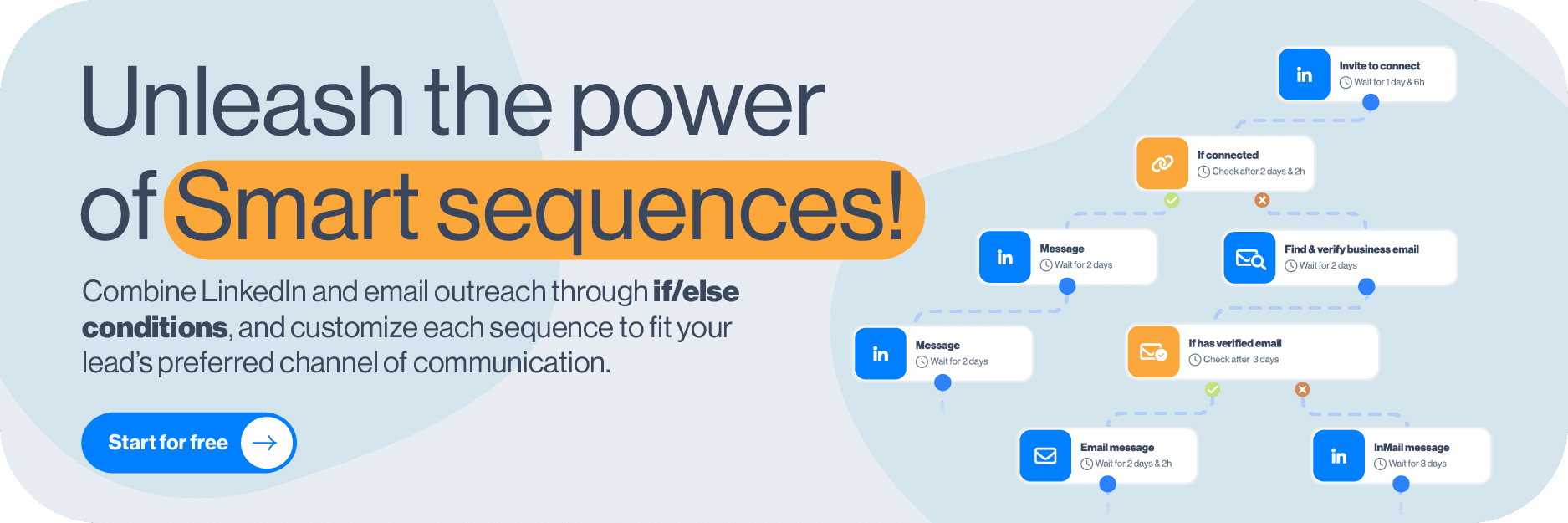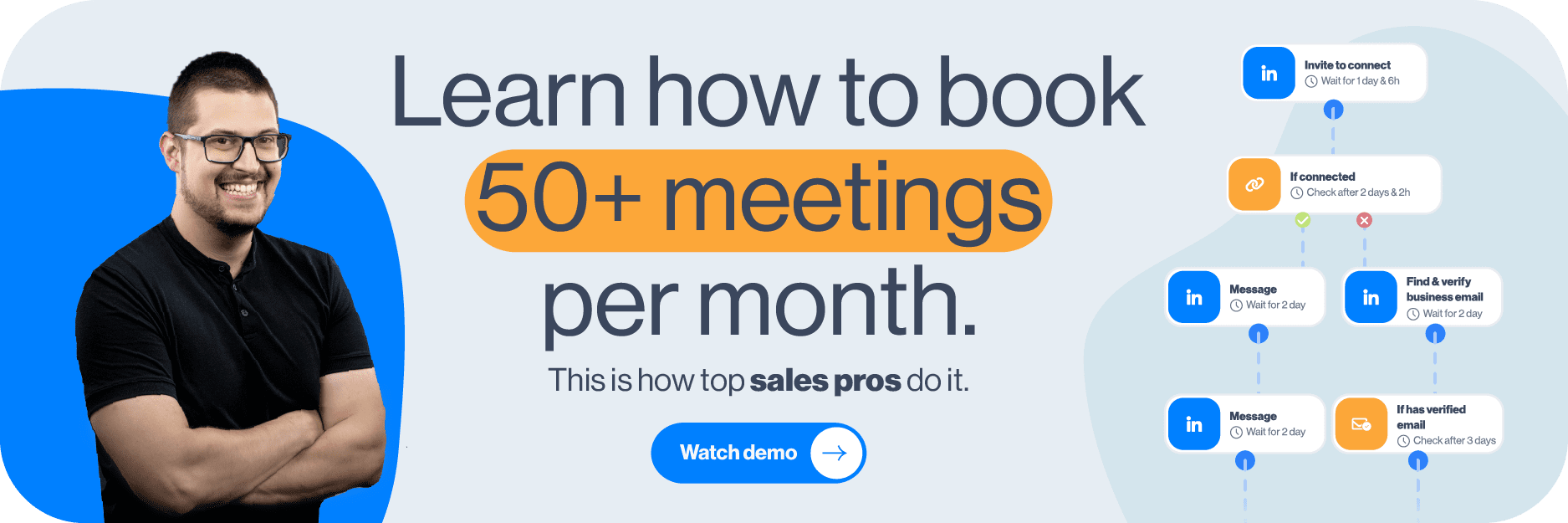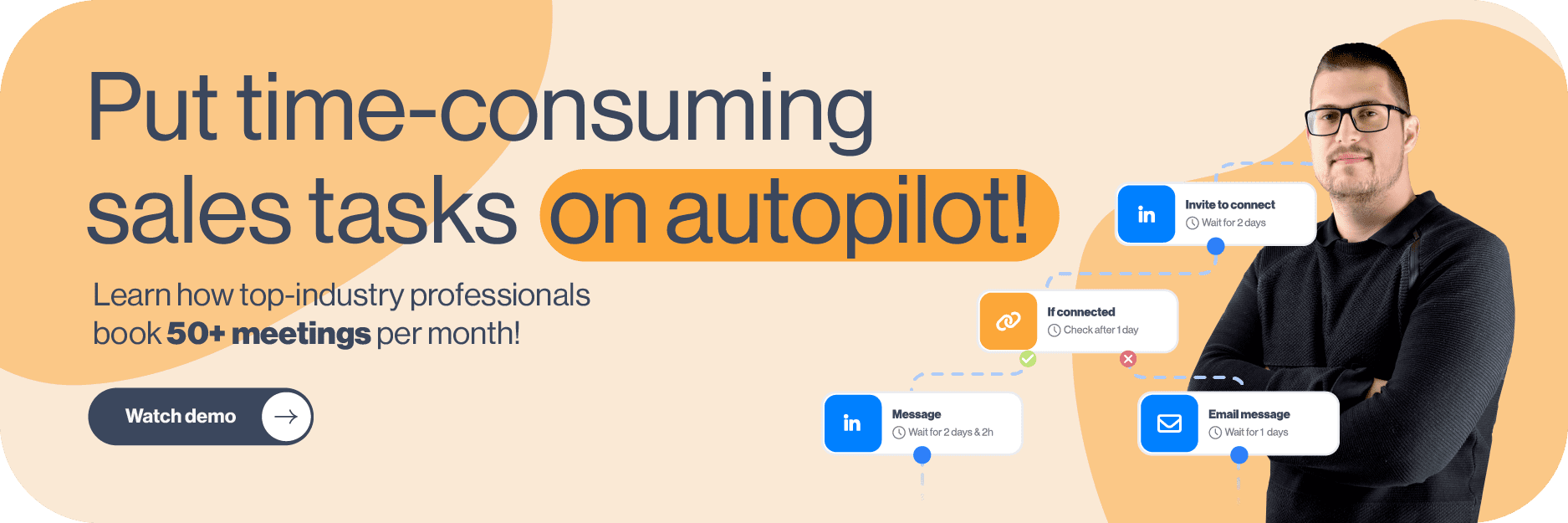To follow up or not to follow up?
Your first email got ignored. We’re sorry to hear that. Most of the time, that will be the case, and that is why you should focus your attention on follow-up emails. But why bother?
What if we told you that by sending a single follow-up, you increase your response rate by 9-13%? And if you keep sending more follow-ups, you can increase the response rate by three times?
We’ve come to find that crafting a good follow-up can be challenging. First, you must grab your prospect’s attention and point it to your email in an overly crowded inbox. Second, you need to make sure to put the right information in all the right places. Why? Well, to get a response and, hopefully, book a call.
Sounds complicated, doesn’t it? Do not despair. We’ve got you covered! Our sales and marketing teams came together to write this article only to help you learn and explain:
- How to write a follow-up after no response;
- The dos and don'ts of follow-ups and what to avoid;
- How can follow-ups increase your response rate;
- How to use a multichannel approach for your follow-up emails;
Bonus: You also get to enjoy tested-for-efficiency follow-up email after no response templates.
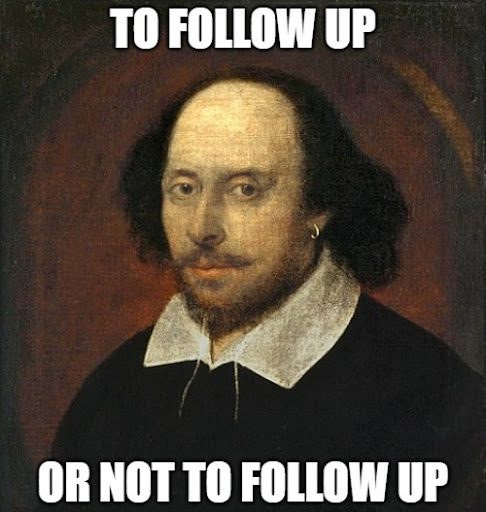
What is a follow-up email?
A follow-up email represents a message sent to a prospect you’ve already contacted before. Usually, the main intent behind a follow-up is to remind the prospect of your first email, request additional information, or remind them of an important meeting or event.
Follow-up emails are a star of the show in the B2B world, which includes sales, marketing, job hunting, recruiting, and customer communication. When it comes to sales, you can use them for lead generation, warmup, and lead management. The same goes for recruiting and job hunting, too.
Why is it important to send follow-up emails?
Always remember that there could be a number of reasons why your prospects aren’t responding after the initial email. Here are some:
- They are too busy.
- They forgot to respond.
- The message is not clear.
- They are not the decision-makers.
- They are genuinely not interested. (in this case, use objection handling to win them over)
What we can conclude from our experience and the experience of others is that sending follow-up emails pays off.
When it comes to sales, our sales team assured us that this statistic is true: sending follow-ups can increase the chances of a response by 25%. If we know that 70% of salespeople stop after one email, then you can use this info to your advantage and incorporate follow-ups into every outreach attempt.
In fact, we’ve witnessed firsthand that follow-ups are crucial for B2B sales outreach, and if you’ve done prospecting on LinkedIn right, you will have a higher chance of hitting that sales quota in no time. Just ask our sales team!
When applying for a job, sending follow-up messages after a one to two-week wait can be a professional way to further underline your interest in the position. Moreover, you’ll get to find out the stage of the hiring process. Lastly, this could encourage HR to take another look at your resume, thus possibly giving you a second shot at the job.Lastly, lead management is only done right with a handy CRM and when follow-ups are heavily involved.
When should you send a follow-up email after no response?
In sales and outbound marketing, sending cold emails creates a need for follow-ups. In outbound email marketing, you are reaching out to potential prospects for the first time without them stating their interest prior. This is why follow-up emails are necessary, but the question is when should you click send your email for the second or third time?
From our experience, picking the right time to send a follow-up email can affect the open and response rates significantly. The norm is to wait anywhere from 2-5 business days before you touch base with your prospects again. The trick is to put yourself in your prospects’ shoes - they might be busy, or they still haven’t had a chance to read or respond to your email.
Sending premature follow-ups can make your prospects lose interest and end potential communication before it even starts. For example, you can send the first follow-up after 5 days, giving them enough time to read the email. In case there’s no response after the initial wait, you send a second follow-up for a gentle bump-to-top in their inbox.
How to write and send a follow-up email after no response
Andrea, our Head of Sales, once said: “A follow-up email after no response should be powerful enough to offer the right value and inspire the desired response at the same time.” The question is, how do we deliver an email with such strength? Our sales team has the knowledge and experience, so open your notes, people. The class on “Writing and sending follow-up emails by Skylead” begins now. 👇
Subject line
Have you heard? Crafting an eye-catching subject line is directly correlated to a higher open rate. Good email subject lines and pre-header text combined are what help prospects make the decision whether or not to open and read the email. If you didn’t have a chance to catch their attention the first time around, use your follow-ups for a second chance for a first impression.
When creating compelling subject lines, our sales team recommends following these simple rules:
- Keep it short and to the point.
- Our CEO, Relja, says that catchy subject lines should be under 55-60 characters for web inboxes and under 30 characters for mobile inboxes.
- Limit punctuation marks (our research suggests that more than 3 punctuation marks may look like spam)
- Avoid all caps and exclamation points.
- Be careful with emojis (we’ve found out through testing that you should use 1 emoji at a time and that you shouldn’t replace words with emojis to avoid not being clear)
- Personalize your subject lines.
Pro tip: Always A/B test your subject lines for efficiency. From our testing, we found that a high open rate is an indicator of a good subject line. Subject line optimization based on real-time results can significantly improve your response rate over time.
Follow-up email subject line examples
For Web Inboxes (55-60 characters):
- {{firstName}}, this is your future workflow using SaaS! 🚀
- VIP sneak peek: You unlocked new features 😎
- {{firstName}} I need your advice
- {{firstName}}, let's make Q4 legendary together
- Your Q4 game-changer inside
- {{firstName}}, let's co-create magic for {{companyName}} ✨
- Tick-tock! Your Free Trial is Ending 🕰️
- Marco? Polo! Seeking Your Response
For Mobile Inboxes (under 30 characters):
- Your secret SaaS weapon 🌟
- Let’s join forces 👊
- Shortcut to {{benefit}} 🙌
- {{firstName}}, get started 🆓?
- Time to grow, {{companyName}} 🌱
- Does this work {{firstName}}?
- Supercharge your {{workflow}}! ⚡
- Missing chat: Still tuned in?
Opening
Once you’ve caught their attention, our sales account executive, Pavle, says that how you greet them is what determines whether they’ll keep on reading. Avoid intros like “Just checking in to see if you’ve read my last email” or “I’m just following up on my previous email.” Such intros are overused and could imply blaming the prospect for not responding, which is a big no-no in sales communication. Instead, say something like this:
- I know we’ve talked about {{painPoint}}...
- As we quite recently connected, I thought it’s only fair you know something about me as well…
- Hi {{firstName}}! I can’t believe how time has flown by since the last time we spoke. I just saw your post on {{topic}} and thought it was amazing. Anyway…
Let’s review the follow-up email after no response opening rules:
- Start with a friendly greeting.
- Briefly remind the prospect of your original email by restarting the conversation (like in the examples above)
- Clearly state the purpose of your follow-up.
- Don’t be afraid to get creative and use humor in outreach.
Bonus hack: Personalize intros - by adding some personal information about your prospect, you show them general interest and that you’ve done your homework. People want to feel special, so be sure to go that extra mile to show them that they are not just another prospect to you.
Our sales team tested our hyper-personalized sequences, and the results show that the response rate increased from the industry standard of 8.5% to a staggering 35%.
Follow-up email opening examples
- Hey {{firstName}}!
Between caffeine doses and back-to-back meetings, my previous email about {{ToolName}} might've slipped through. Thought I'd pop back into your inbox. How does it look from your end?
- Morning {{firstName}}!
Did my last email decide to play hide and seek in your inbox? 😅 I chatted about some exciting rates and am curious to hear your thoughts.
- Hello {{firstName}},
Knowing how swamped we can get, I figured I'd circle back. Our conversation about a possible partnership had me excited. Where do you stand on it?
- Hi {{firstName}},
Last time, I dropped a hint about {{ToolName}}'s shiny new feature. Just like waiting for the kettle to boil, I'm here, curious: Any thoughts brewing on your side?
Still having trouble with your email opening lines? Try reading our guide to attention-grabbing cold email opening lines. Don’t skip out on the templates!
Body
We’ve covered the follow-up email openings after no response. Now, let’s dive into our sales team's tricks of writing a great email body:
- Be concise - clearly written emails win over prospects.
- Keep it short - from our experience, longer emails could negatively affect the response rate.
- Be specific - no need for filler phrases and words.
- Be polite and professional - People value manners, and if you’re not being too aggressive, you might get a chance to pitch.
- Offer value - People want to see the value behind your offer. If you’ve done your prospecting well, you’ve caught some people who can largely benefit from what you’re selling. Be sure to add some extra value by underlining some known issues that your tool/product/service fixes for them or by sending educational content.
Our pro tip: “Do not think of each follow-up as spam. Think of them as added value with each new message you send.”
Closing & call to action
Our sales team says that when you write a closing and a final CTA, you need to create a perfect environment for your prospect to respond. That means:
- No vague statements - Do not confuse your leads with overly complicated demands at the end of the email.
- A clear and short call to action - Sales experts agree that a good CTA is the last thing your prospects read and the first thing they do.
Follow-up email closing examples
- How about next week? Does Wednesday at 11 PM work for you?
- Dive into the feature's details by hitting reply.
- Plot our next collaboration chapter? Choose your preferred time here.
- Respond with "Let’s do this," and I’ll send more educational content your way.
Still feel like you need some help with your CTAs? Check out our guide on creating a powerful sales email call to action in sales emails, and don’t skip the CTA examples part!
Using automation tools to send follow-up emails
Now that we’ve covered crafting follow-up emails after no response, let’s look at the next step - sending follow-up emails. Outreach emails might be hard to track, especially if you have a lot of prospects in your inbox. Plus, keeping track of the number of follow-ups sent, the context, and the goals for each specific lead can be challenging.
Now, before your outreach turns into a huge mess, you should ask for some help. And you know what? It sounds like what you need, dear salesperson, is LinkedIn automation and cold email software for lead organization and follow-up email sequences.
Let’s look at the numbers one more time. Andrea says that from our experience, the first and the last follow-ups get the most attention:
- with the first follow-up, the response rate increases by 43%
- the last follow-up - “breakup email” receives a 53% response rate
That’s a lot of follow-ups to keep track of. However, by using automation and email message sequencing, you can rest assured that all your messages are being delivered in a particular order. Now, your question is: where can I find such a platform or tool? 🤖

How to do it?
This is where we come in, with a big grand entrance, only to introduce Skylead and our all-star, first-to-market feature Smart Sequences. With the help of our Smart sequences, you can use multichannel outreach messaging and personalization to supercharge your sales efforts! Smart sequences are algorithms that allow you to combine if/else conditions with outreach actions. This way, you can create scenarios based on your prospects’ behavior, ensuring you get a response from them one way or the other.
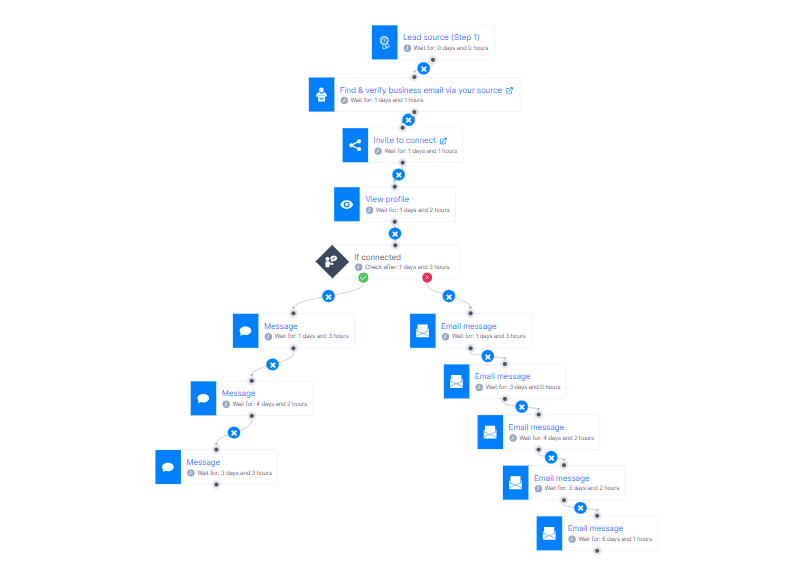
Use Skylead to:
- Create smart message sequences
- Add hyper-personalized elements such as dynamic text or images & GIFs
- Use LinkedIn as an additional channel and explore multichannel outreach
- A/B test your content, analyze and optimize campaigns
- Keep track of each follow-up in the Smart inbox and label leads that require additional follow-ups.
Apart from follow-up message sequences for sales, marketers can also benefit from our tool. By using marketing automation, you can get more web traffic, drive conversions, collect event attendees, and raise brand awareness.
Either way, using SaaS tools or doing the work manually, you can organize your follow-up emails after no response in a sequence and incorporate a multichannel outreach. In Skylead, setting your follow-ups in a sequence is as easy as 1,2,3, and the sending process itself is done for you. Let’s show you a simple, multichannel sequence in Skylead if the lead didn’t respond.
Example of a follow-up sequence when you are connected with the lead on LinkedIn:

Why it works
Setting up your sequence to include an outreach channel other than email works best, as it shows your prospects that you care about making a connection with them, and they are more likely to respond to you.
Furthermore, in this sequence, LinkedIn acts as a powerful and supportive lead generation tool, as you can interact more with your prospects and increase the chances of them seeing your message and responding. Just make sure to prepare your messages for the outreach carefully.

But how do you write them? Well, the next chapter is where we unveil the tips and tricks, so keep reading to find out. 🙌
Tips for writing effective follow-up emails
Our sales force, Andrea and Pavle, are back to help you by spreading their knowledge and gifting you with more tips on how to write effective follow-up email copy. Keep this in mind: hard work does not stop at the first email - it continues and increases. First off, let’s look at the do’s.
Start with a strong opening.
A strong opening is like a good first impression. Well, in this case, it's a second first impression, so make sure to avoid overused phrases and email cliches at all costs.
Use storytelling in the follow-up sequence
There are many approaches you can take with your sequence strategies, and one of them is storytelling. For example, you could invite them for an online coffee, and the entire sequence can have a coffee conversation theme.
The idea is to reveal one value to the pain point at the time in every following email, enhancing its value as you go. You can speak about the value in ascending order of importance, with each email being more important than the last.
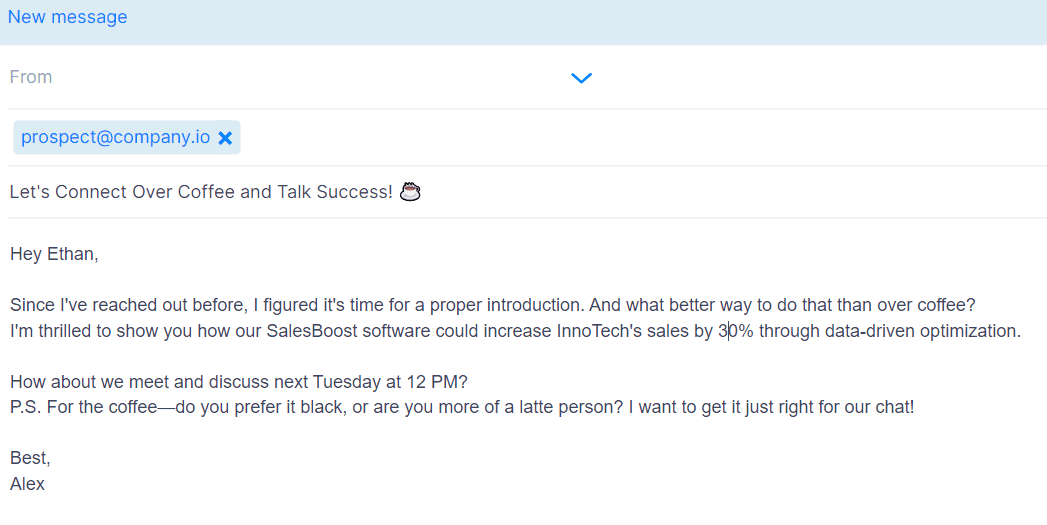

Personalize your follow-up emails whenever possible.
Personalization shows you’ve made an effort to get to know your leads. And despite the fact that you’re reaching a certain target group, it doesn’t have to seem automated. You can use Skylead and our image & GIF personalization feature to add some sparkle to your follow-ups. You can also add dynamic text to follow-ups to increase the level of personalization in outreach.
Get to the point quickly.
From what we’ve seen and from what you can tell from your own experience as an email reader, losing your prospect's attention is easy. It only takes a few mistakes, and your email is done for. Avoid all this by getting to the point quickly. No long sentences, no short novels, just facts and a little bit of creativity to keep them reading and ultimately doing the CTA.
Space out your follow-up emails.
If you’re being too salesy and aggressive, you’ll lose a good portion of your prospects. No one wants to be bothered, especially in the case of cold outreach. Make sure to space out your follow-ups anywhere from the standard 2 to 5 business days.
Pro tip from Skylead’s sales team: Give your prospects enough time to respond. Some of them might be too busy to go through your emails and have not had a chance to read them yet. Sending too many follow-ups after no response doesn’t seem like a friendly reminder or check-in but rather a pushy salesman trying to shove their product/service down their prospect’s throat.
Show credibility.
Cold outreach can be tricky. It’s hard enough you’re trying to establish contact out of the blue, but you’re also asking for something. Prospects are usually not so trustworthy with cold emails, so in order to show them that you’re serious, you need to show credibility.
We’ve mentioned that every follow-up email should add extra value. Use each follow-up to show them your accomplishments - link to credible sources, testimonials, and case studies that can help them decide whether or not to trust you.
Offer value.
Your prospect’s first thoughts are usually, “Why is this person contacting me?” or “What is this person trying to sell?”. By following our rules of writing follow-up emails after no response from the section above, you’ll lead them straight to the point with your follow-up email, underlining the value of your product or service.
Throw some numbers around. People respond to numbers and statistics well. Prospects appreciate value, and if you offer them a solution to a niche problem, the conversation will just keep flowing.
Be empathic.
Another pro tip from our sales team: You need to listen to your prospects carefully and truly understand their issues. If you know they have a problem your product can fix, try approaching them in a subtle way where you show them compassion. Once you get a reply, your work doesn’t end.
Create urgency.
You can probably guess that creating urgency is what makes your prospect believe he should take immediate action by replying to your message. However, if it did not work for the first time, you can create more urgency in your follow-up, but be subtle.
Our pro tip: Don’t use sensational subject lines and promises you can’t keep only to lure them into replying.
Common mistakes to avoid
Andrea and Pavle are full of knowledge when it comes to the dos of sending follow-ups after no response, but after years of sales experience, they can also easily spot cold email mistakes. The list below shows what you shouldn’t do if you want a high reply rate with your follow-up email sequence. 👇
Following up too quickly.
One of the main rules of cold outreach is not to spam your prospects with messages! Be patient. Nobody likes an overly aggressive approach. The industry standard is to spread your follow-ups out by roughly 2 to 5 days. If you wait for more than that, it will probably reduce your chances of getting a reply.
It’s a good idea to map out your follow-ups inside your Smart sequence in the correct order and wait for a reply. You can thank us later.
Sending too many or not enough follow-up emails.
What is the optimal number of follow-up emails you can send to a prospect before that final “breakup” email? We know for sure that sending just one email isn’t enough. So, we take into account that by sending each follow-up after no response, you increase your chances of a reply. That said, it’s safe to say somewhere around 3-6 follow-ups is enough.
From our own experience, a prospect says “no” 4 times before saying “yes.” That’s why this range works perfectly and might get you that desired result.
Being too pushy or aggressive.
We’ve mentioned this before - people do not respond well to aggressive salesmen and aggressive job seekers. Being direct and pushy are not synonyms. It’s one thing to show prospects or employers your interest in them, but another to demand and be borderline rude about your approach. It’s all about setting a fine line between being subtle yet decisive and direct. You can sell without sounding too salesy.
Missing important information.
You’ve probably received an email that’s missing crucial information in the past. Heck, we all did at some point. Sometimes, the email is very catchy and inspires immediate action, but wait. Parts of it are missing. It could be a missing attachment, a link, or some other information. That means you’re creating an additional step for the prospect. They will have to ask you for that information, but as you know, most of them won’t. The lack of crucial or promised information can be very offputting to prospects, so make sure to double-check if all the info is in each follow-up.
Not proofreading.
This one is tied closely to the previous advice. We’ve noticed that mistakes are not tolerated by prospects, so make sure to go through your follow-up sequence and maybe get a second pair of eyes on it. Mistakes show sloppiness and a lack of interest in the prospect. Plus, they can also be perceived as spam.
Check for typos and grammar, and if all attachments and visuals are there, along with all the necessary information, then you can click send.
Writing too much text.
If the email body is too long, your prospect won’t read it. It’s that simple. Our sales team has tested longer and shorter versions of the same follow-up sequence and saw significant differences. Shorter emails have received a higher response rate.
Not having a clear call to action (or too many of them)
Our head of sales, Andrea, always reminds us that you have your prospects’ attention for a very short time. Make sure to have only one and a clear call to action. Otherwise, you’ll lose their attention quickly, and you won’t get the desired action from them.
Not offering an unsubscribe option.
Given the fact that you’re contacting these people without their consent, some of them might feel the urge to unsubscribe (hopefully not if you’ve done your prospecting right). Nonetheless, adding an unsubscribe option is good manners. Plus, you’re helping deliverability, reducing spam rates, and improving your reputation. You want active users/subscribers in your email lists, so adding an unsubscribe option is how you help yourself.
Sending emails to the wrong person.
This is a part where we talk a little bit about prospecting. Knowing your product/service is where you begin before you think about your audience. Thought about it? Good. Now it’s time for prospecting. However, if you have trouble with this step, here is a guide to the best LinkedIn prospecting strategies so you can get to the right person every time.
Skylead tip: If you’re sending emails manually, make sure to spell their name correctly.
Sending a follow-up email after no response samples & templates
We’ve come to the part of the article where our sales and marketing teams put their knowledge to the test. Get ready for follow-up email examples after no response (salespeople, recruiters, and job seekers, take notes!). Feel free to use them and test their efficiency yourself. 🤓

#1 Reminder email after no response (first follow-up)
Subject: Tap Tap: Is This Thing On? 🎤
Hey {{firstName}},
Sending a cheerful nudge your way! Seems like our chat about {{topic/Issue}} decided to take a little vacation. Ready to welcome it back whenever you are.
Eager for the sequel to our chat,
{{yourName}}
Real-life example:
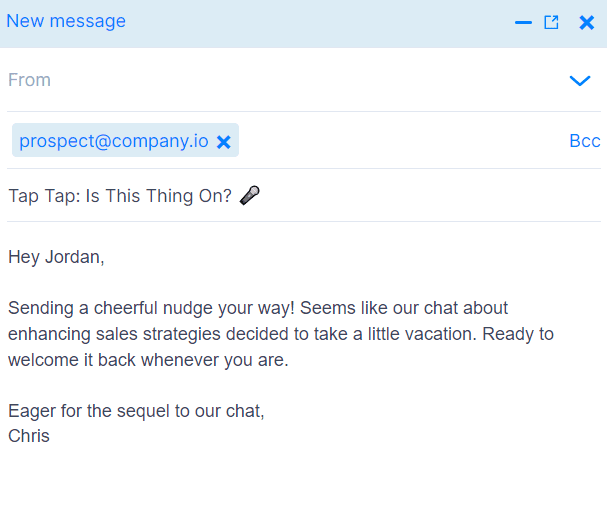
Why it works: One of the major rules of writing follow-ups is not to be afraid to have fun. Being humorous is something that most people respond to well.
#2 Reminder email after no response (second follow-up)
Subject: RE: Mic Check for Round Two? 🎤
Hey {{firstName}},
It looks like we keep missing each other over and over again. I know things get busy, but I believe that a productive exchange is worth every second!
How’s {{date/Time}} for an encore of our previous productive chat?
Real-life example:
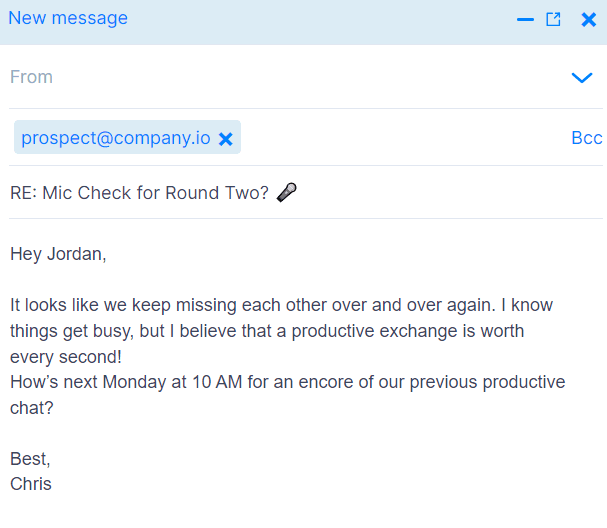
Why it works: In the second follow-up, you are showing your prospect that you are consistent. It’s short, and it shows your outreach efforts clearly.
#3 Follow up sales email after no response
Subject: Green, Yellow, or Red for {{product/Service}}? 🚦
Hi {{firstName}},
Our chat from last week about {{product/Service}} seems to be idling at a traffic light. Which color are we on?
If you're stuck at yellow, need more green insights, or hitting red, I'm all ears.
To clear signals,
{{yourName}}
Real-life example:

Why it works: Avoiding boring lines and overused sentences is crucial for any outreach email. Plus, this one shows you got inspired and took the time to write a creative follow-up with a witty comparison.
#4 Follow-up email after no response (formal)
Subject: Revisiting Our Lost Thread
Hi {{firstName}},
The daily email cluster must have pushed our thread regarding {{topic/Issue}} down the inbox black hole. This note is a gentle nudge, hoping to push our conversation back to your attention.
Eagerly waiting for your reply.
Best,
{{yourName}}
Real-life example:
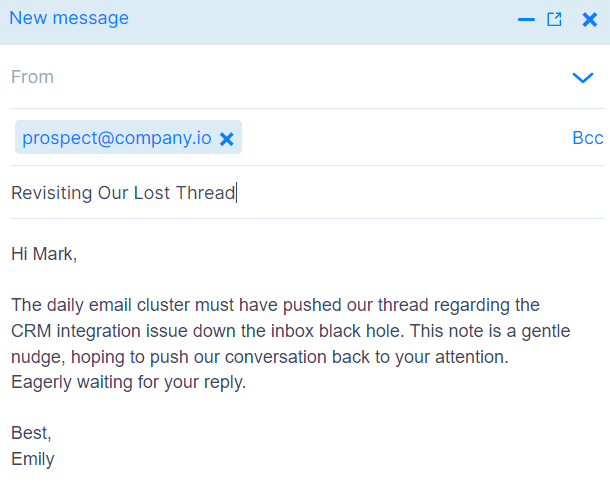
Why it works: Although most business communication nowadays tries to steer clear from generic and cliched email communication, being formal has nothing to do with that. This follow-up email shows that you’re polite and well-mannered but also clear with your intentions.
#5 How to bump an email politely
Subject: An Elevator Pitch: Bringing Our Chat Up Again
Hi {{firstName}},
In the vast sea of daily emails, I’m sending this note as a gentle elevator, hoping to lift our previous discussion on {{topic/Issue}} back in focus.
Looking forward to your insights!
Ready for your reply,
{{yourName}}
Real-life example:

Why it works: Your email got lost in the daily bunch. How to get it back into the limelight? By sending a polite follow-up email and replying to your primary thread and stating your purpose once more. This one works because it’s a creative way of showing the recipient that you demand their attention.
#6 Follow-up email after no response from a client (sales)
Subject: Piecing Together Our {{product/Service}} Puzzle 🧩
Hi {{clientName}},
Seems our dialogue on {product/Service}} took a quiet turn. Are there missing pieces I can help with?
If adjustments or additional support is needed, I'm ready to jump in. Just give me a sign.
Awaiting your cue,
{{yourName}}
Real-life example:
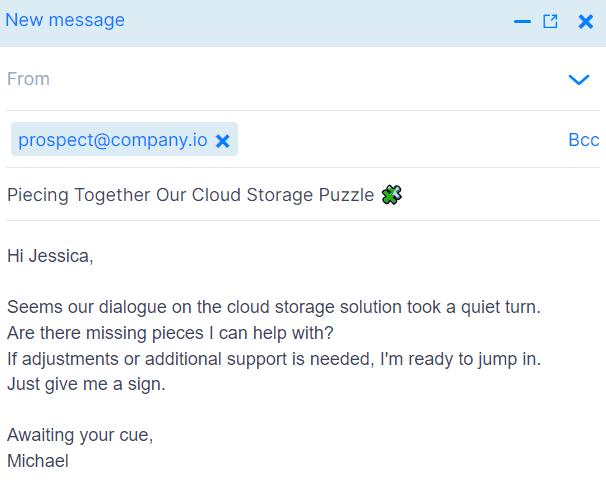
Why it works: Offering your help and support is sometimes just what a client needs to clear their confusion. This is not a potential client but a doubtful client. If the client is doubtful, you could lose the account, so make sure to follow up frequently and gently.
#7 Follow-up email after sending resources (sales)
Subject: Resource Roundup: Hit or Miss? 📚
Hey {{firstName}},
Dived into the resources yet? Would love to know if anything clicked or raised an eyebrow about {{product/Service}}.
Got any questions or an 'aha' moment to share? I’m just a call away: {{yourPhoneNumber}}.
Warmly
{{yourName}}
Real-life example:
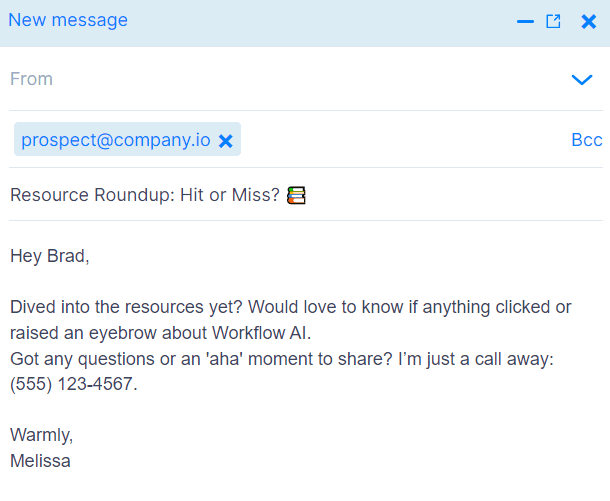
Why it works: Gentle reminders in email form are much needed in the cold outreach game. This template is not aggressive, has a friendly note, and just the right amount of pressure on your end.
#8 Follow-up email before free trial (sales)
Subject line: Dropping A Quick Present 🎁
Hey {{firstName}},
Just wanted to say thanks again for the call. As we talked about {{painPoint}} and explored your company's current strategies for dealing with it, my belief was reinforced that {{yourProduct}} can help with achieving {{metricValue}}.
That’s why I included a little gift for you: {{giftRegardingFreeTrial}}, so you can fully try our product out and experience {{MetricValue}} firsthand.
Let me know when you start the Free Trial so I can send it to you.
Cheers,
{{yourName}}
Real-life example:

Why it works: This is a short, precise email that the prospect doesn’t waste time reading. With exact value and a gift to top it off, which everyone likes to get, you will be sure to get a high response rate.
#9 Follow-up email after demo (sales)
Subject: Post-Demo Checkup 🧐
{{Date}} was not just another crossed-out meeting. Let’s recap:
{{yourProduct}}: Not just a tool, but a {{benefit}}.
{{theirChallenge}}: On our radar now.
If you’re wondering what's next, have any doubts, or need more details, let’s discuss.
How about a second quick chat on {{date/Time}}?
To making ‘just another day’ count!
{{yourName}}
Real-life example:
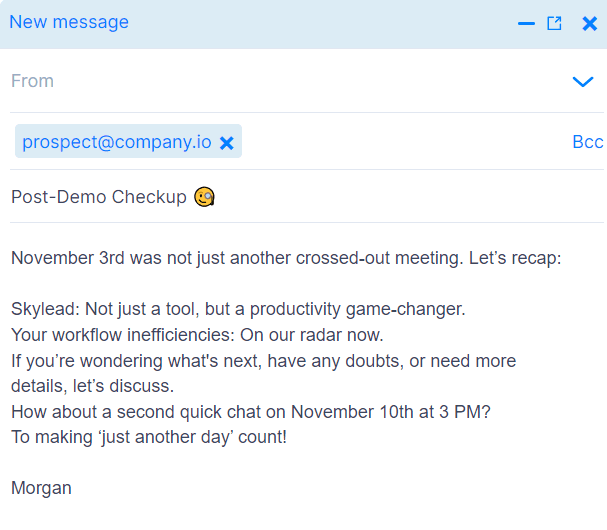
Why it works: Checking in with your prospect after a demo is just as important as the demo itself. Demos can be confusing for some, and not everyone is prepared to process all the given information. This is your chance to remind them that you can clear any confusion they may have and ultimately lead them to the next step - conversion.
#10 Follow-up email after a missed call (sales)
Subject: Call Missed: Ready for Redial? 🤙
Hi {{firstName}},
Seems our phone lines played hide and seek earlier when I called about {{product/Service}}.
Let's hit redial and aim for a good connection. How does {{suggest a specific day/time}} work for a quick chat? Or simply shoot me a time that works for you.
Cheers,
{{yourName}}
Real-life example:
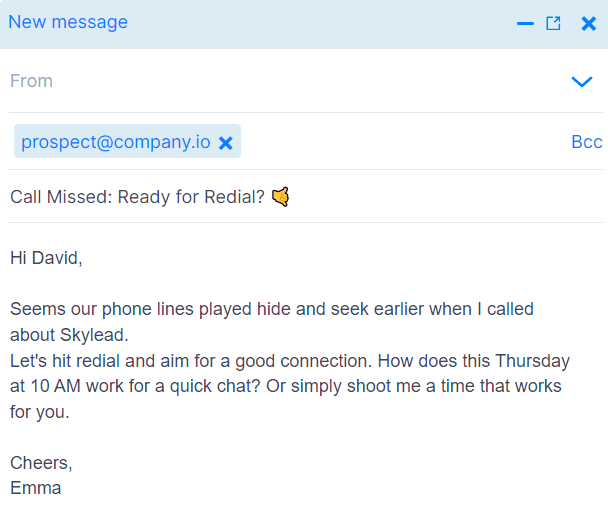
Why it works: Missed calls and meetings happen all the time. This is where this template comes in handy. It’s short and direct but has that tiny bit of informality that you need to get another chance at an online encounter. Remember: sales follow-ups are important!
#11 Follow-up email that mentions the competition (sales)
Subject line: Wish to know the truth about {{competitorName}}? 🤫
“You can’t handle the truth!” said Jack Nicholson.
Just kidding, {{firstName}}.
Hope you are doing well. Just thought of knocking on your door and leaving a comparison page - {{yourProductName}} vs {{competitorProductName}} since I know you’ve been testing them as well.
Are you up for a quick chat to discuss the main differences and the benefits I sent previously?
Cheers,
{{yourName}}
Real-life example:
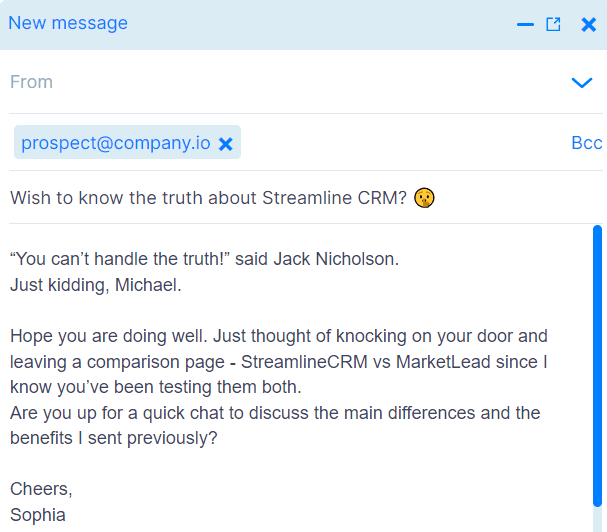
Why it works: In case you already sent your prospect benefits and your prospect has been considering your competitor as well, this is the second follow-up email you send. Show them your benefits before they make a decision and run over to your competitors.
#12 Personalized follow-up email after no response (sales)
Subject line: Tailor-made strategy for {{company}}🧵
Hey {{firstName}},
{{painPoint}} must be tedious for you. Luckily, you are not alone in this.
Since my last email, I have created a couple of strategies tailor-made for your company on how you can {{result}}. Want to hear them?
If so, does {{date/Time}} work for you?
Real-life example:

Why it works: Adding personalization, such as name, image, or pain point, achieves the best results. However, if you have a low-buying-intent prospect who didn’t respond to your email, you need to go the extra mile. In other words, you need to create something applicable and tailor-made for their company to warm them up to your product.
#13 Follow-up email after sending a contract (sales)
Subject: Contract Follow-Up: Let’s Turn Pages Into Progress 📑
Hey {{firstName}},
The contract for {{product/Service}} is now on your desk. Peeked inside yet?
If any question marks or clarifications are needed, I’m just a call away. Contact me at {{yourPhoneNumber}}.
To turning pages,
{{yourName}}
Real-life example:
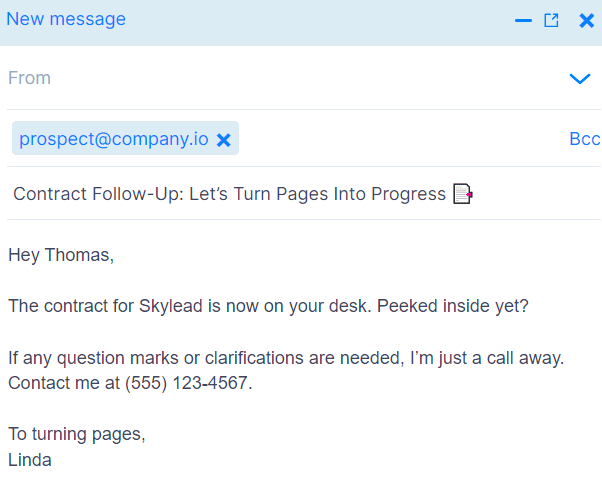
Why it works: After writing thousands of emails, we can say that finding the right balance between formal and informal communication is the key to success. Being too stiff and talking in a manner that wouldn’t reflect a live conversation is outdated. When writing, think about what you would say if your prospect were sitting in front of you.
#14 Follow-up email after a couple of months (sales)
Subject line: Hello from the other side - With exciting news 🗣
Hi {{firstName}},
I haven’t called a thousand times, as Adele, but as promised, I am checking in after a while.
How have you been? How did {{reasonForReachingOutLater}} go?
I have super exciting news to share with you. We have just {{companyNews}}. I thought you might like it as it can help you {{achieveResult}}.
Let me know if you are available for a quick call to catch up on everything that has been going on. Here is my calendar link.
Looking forward to hearing from you,
{{yourName}}
Real-life example:

Why it works: In case you haven’t had communication with your prospect for a while, you can send this or a similar follow-up. For example, the lead might have told you to reach out in the future. When you asked when exactly, they didn’t respond. The good practice here is to reach out after a month and check-in. They might be more open to hear what you have to say and offer.
#15 Follow-up email after a LinkedIn connection request
Subject line: Bridging Barriers: From LinkedIn to Real Talk 🌉
Hi {{firstName}},
It seems we missed each other on LinkedIn, so I’m reaching out via email. Your stance on {{topic/IndustryTrend}} is a real conversation starter, and it works!
I believe there’s a bridge to be built here and a productive conversation to be had. How about we put words into action? Is {{time/Date}} okay for you?
Looking forward,
{{yourName}}
Real-life example:
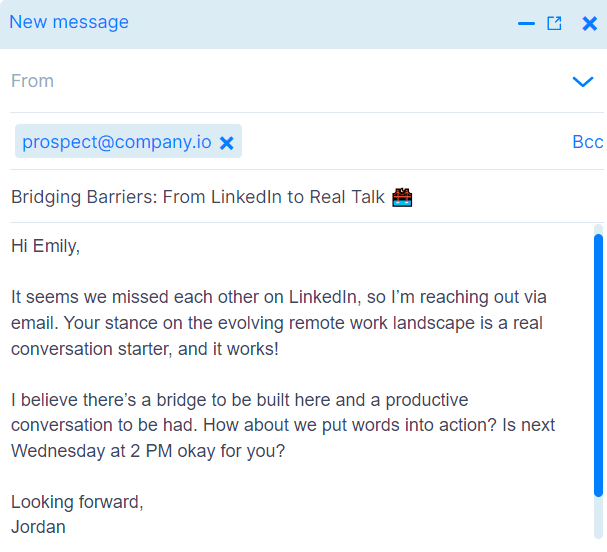
Why it works: Use a follow-up email to reach out to a member of the LinkedIn community that you tried contacting by sending a connection request, but the prospect hasn’t accepted it yet. Having another conversation channel and putting an effort into starting a conversation there is what your prospect might perceive as determination.
Remember: putting a smile on your prospect’s face is one last step before a reply happens.
#16 Follow-up email after sending a quote (sales)
Subject: Quote Mission: Countdown to Decision? 🚀
Hey {{firstName}},
Hope the quote for {{product/Service}} landed well. Any thoughts or roadblocks?
Let’s not leave things hanging. A quick call might clear it up: {{phoneNumber}}.
Waiting for your signal,
{{yourName}}
Real-life example:
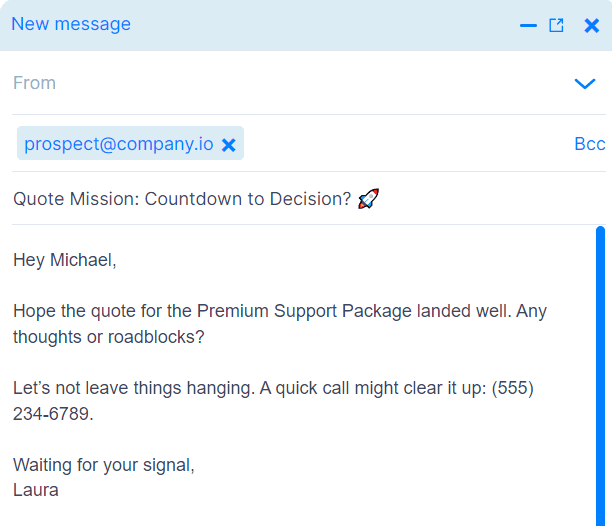
Why it works: The email is short, precise, and with a touch of spice. Just the way your prospects like them. Not being generic goes a long way in cold outreach + adding a phone call option for some busier prospects is also a plus!
#17 Follow-up “breakup” email (sales)
Subject line: Perhaps it is better this way… 💔
Hi {{firstName}},
I sense that now might not be the ideal time for {{yourProduct}} to address {{painPoint}} at your company. No worries at all – timing is everything.
If the future calls for a revisit, I'm here. Until then, I wish you and your team all the best.
Cheers, and until the next time.
{{firstName}}
Real-life example:

Why it works: If you've sent a couple of emails already and none of them worked, this is your sign to stop reaching out. While sending a so-called breakup email, it is best to evoke an emotional reaction from the prospect, as demonstrated in the email below. The key is to stay genuine.
#18 Follow-up email after a free trial (sales)
Subject: Free Trial Verdict: Thrill or Kill? 🧟♀️
Hi {{firstName}},
Just checking in after our thrilling free trial of {{product/Service}}. I’m curious to hear your thoughts!
Were there highlights, or perhaps something you missed? I'm here to clear any fog or explore possibilities.
For a quick chat, just ping me at {{phoneNumber}}, or let me know a convenient time for you.
Eager to hear your take!
{{yourName}}
Real-life example:
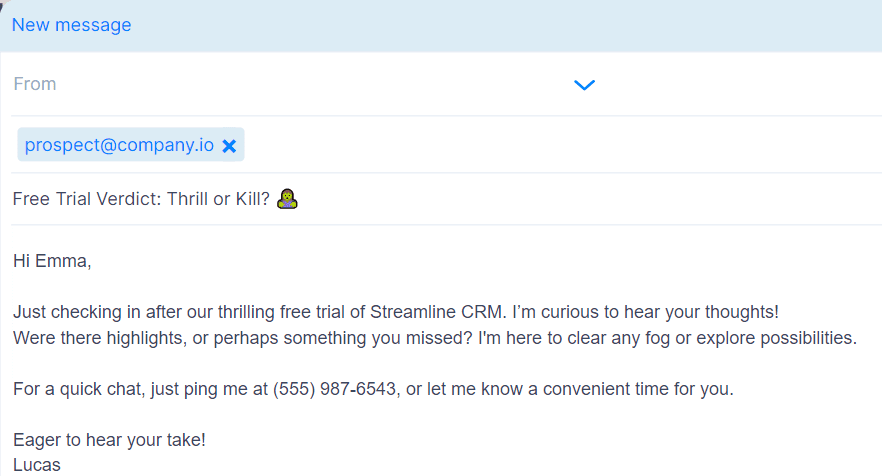
Why it works: Comparing your demo pitch to the best-selling album of all time? We say yes! Everyone likes a well-crafter themed message in their inbox, and chances of a reply are significantly higher.
#19 Follow-up email after no response to a job application (job seeker)
Subject: Resume for {{jobTitle}}: In Your Hands
Hi {{hiringManagerName}},
Wanted to confirm my resume for the {{jobTitle}} position has reached you. Looking forward to exploring how my background can contribute to {{companyName}}.
Awaiting your guidance on the next steps.
Warm regards,
{{yourName}}
Real-life example:
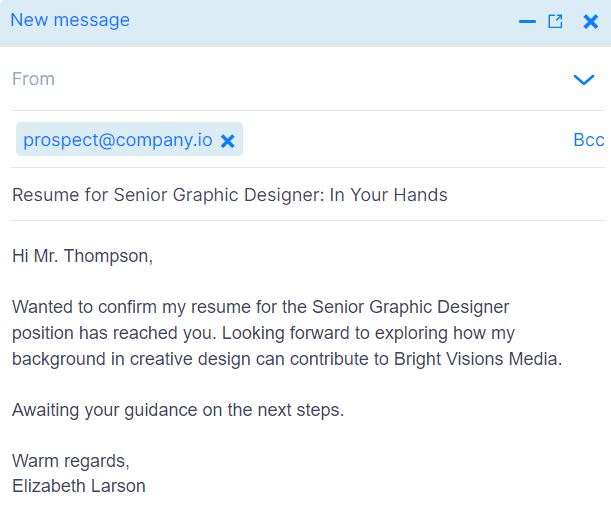
Why it works:
This is a very common scenario: it's been a couple of days or weeks after you’ve applied for the listed job, and nothing happened. So what do you do? You send a polite reminder and ask the hiring manager to give you details about the hiring process. That way, you’ll know where your application stands.
#20 Follow-up email after sending resume (job seeker)
Subject: Resume Dispatch: {{jobTitle}} Role
Hi {{hiringManagerName}},
I want to ensure my application for the {{jobTitle}} has landed in your realm. Ready to discuss how my unique skill set could add value to {{companyName}}.
If a brief chat would help, I’m all ears. Here’s my direct line: {{yourPhoneNumber}}.
Warm regards,
{{yourName}}
Real-life example:
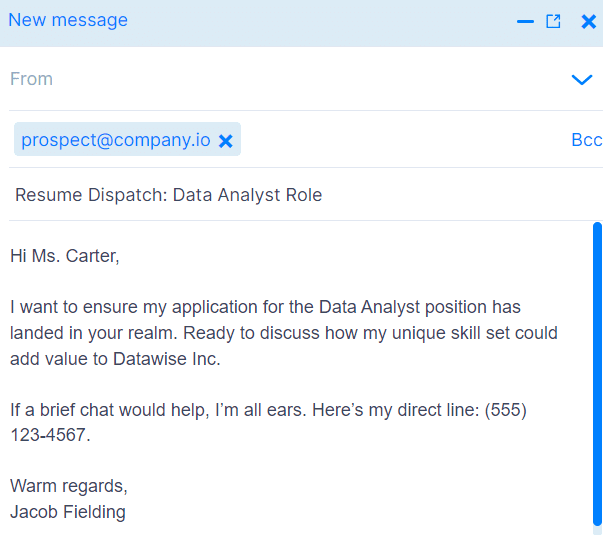
Why it works: When a position is open, hiring managers usually get hundreds of resumes daily and from various channels. Therefore, it’s easy for some resumes to slip through the cracks and go unnoticed. Politely asking the hiring manager if he had a chance to take a look at your accomplishments should do the trick, and give them a slight nudge they might need to notice you.
#21 Follow-up email after an interview (job seeker)
Subject line: Post-Interview Reflections: {{jobTitle}}
Dear {{interviewerName}},
Thank you for the thought-provoking interview. Our conversation opened new horizons, bringing the role and {{companyName}}’s vision into sharper focus.
Looking forward to any updates or next steps.
Warmest regards,
{{yourName}}
Real-life example:
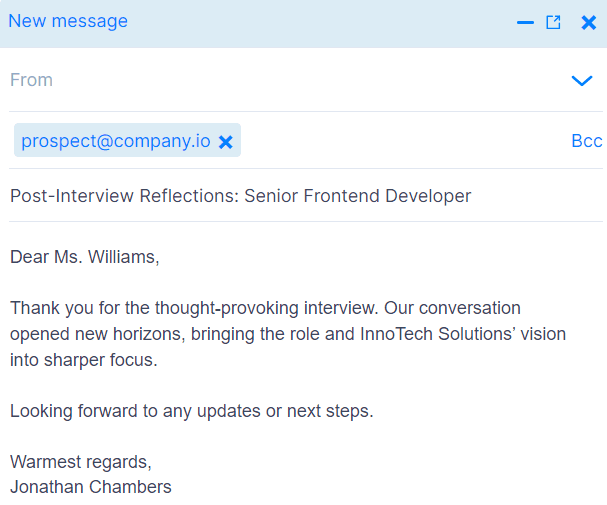
Why it works: Employers want present and engaged employees. If you’re interested in a position at a certain company, don’t hesitate to follow up after an interview. Ask questions, clarify everything that wasn’t clear while the interview happened, and seek out the hiring manager's opinion on how it went. Most job applicants don’t take this extra step, so don’t make that mistake if you’re really aiming to get the job.
#22 Follow-up email after no response after interview (recruiter)
Subject line: Here's the complete offer
Hi {{firstName}},
Time really does fly by, doesn’t it? It’s already {{DayOfTheWeek}} 😄
Anyway, I just wanted to touch base with you and go over our offer once again.
As we discussed, your conditions will be:
- {{Condition1}}
- {{Condition2}}
- {{Condition3}}
In addition, here are the benefits mentioned during our meeting. As our {{position}} you will have:
- {{Benefit1}}
- {{Benefit2}}
- {{Benefit3}}
Let me know how this sounds to you.
Kind regards,
{{yourName}}
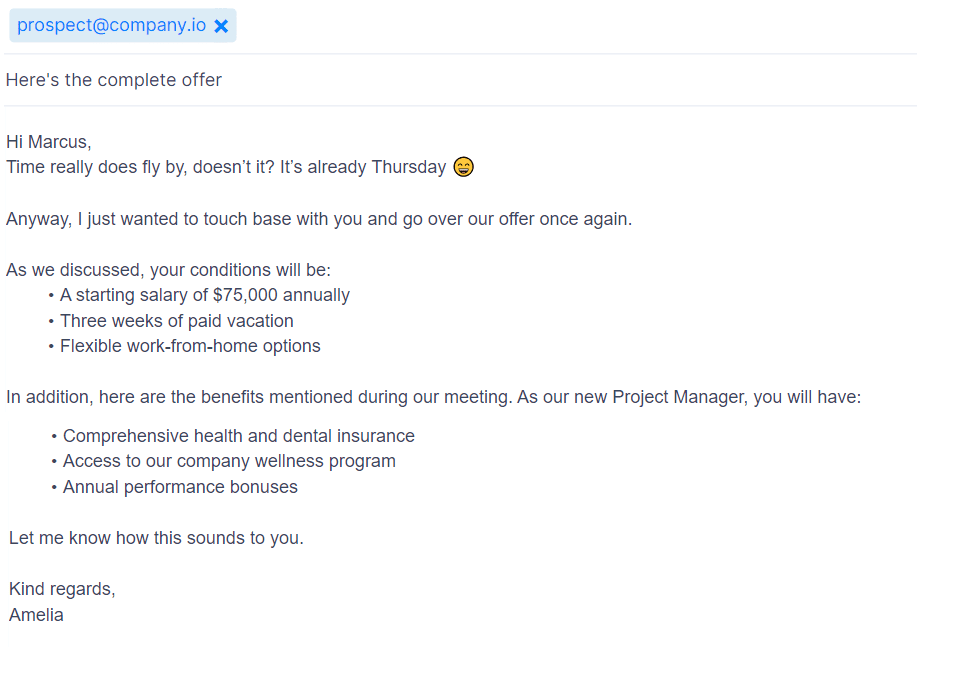
Why it works: We cannot talk about follow up email and not mention our recruiters. If you are an HR person and find yourself in a situation where your ideal candidate didn’t respond to you after the interview where you presented your offer, here is a template you can use to give them a nudge.
#23 Sample follow-up letter for job application status (job seeker)
Subject: {{jobTitle}} Application: Next Coordinates?
Dear {{hiringManagerName}},
I hope this message finds you well-rested and productive. In the quest for the {{jobTitle}} role, I'm writing to seek updates on our current position. Have we reached a new checkpoint, or are there further details I can provide?
Your status update is greatly appreciated.
With respect,
{{yourName}}
Real-life example:
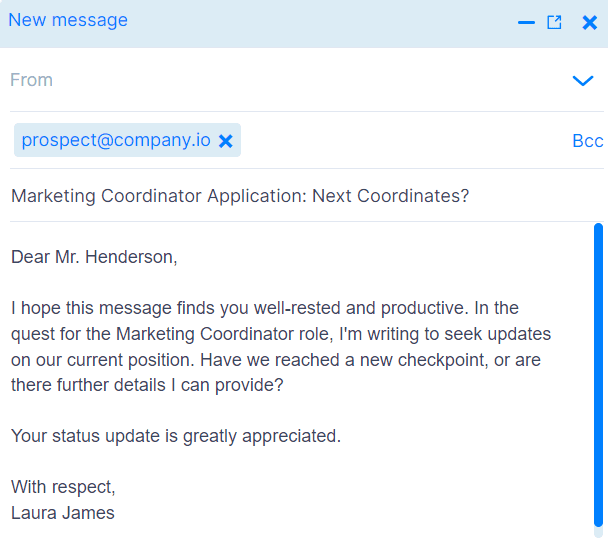
Why it works: Knowing where you stand in the hiring process is crucial when applying for jobs. Plus, it shows your interest in the position and your determination to fill in the vacancy.
Frequently asked questions
What specific strategies can be employed to personalize follow-up emails for different industries or roles to increase engagement?
Personalizing follow-up emails can involve referencing specific interests, recent accomplishments, or industry news relevant to the recipient's field. Tailoring your message to their unique context fosters a more personal connection.
How does the timing of a follow-up email impact its effectiveness, and are there optimal times of day or week to send these emails for better results?
The effectiveness of a follow-up email can be significantly influenced by its timing. Sending emails during business hours, especially mid-week, may improve open rates. However, considering the recipient's time zone and work patterns is crucial for optimal timing.
Beyond the provided templates, what are some creative examples of follow-up emails that have successfully converted initial non-responses into positive outcomes?
Creative follow-up emails often incorporate humor, personalized GIFs & images, comments, or interesting questions that relate to the recipient's interests or industry. Such approaches can help break the ice and engage the recipient more effectively, turning a lack of response into a positive conversation starter.
How do you politely follow up on an email with no response?
Make sure to wait the standard 2-5 business days before reaching out again. Your tone should be professional yet direct. Finally, you should add more value and information. Underlining that your product or service fixes their issues creates the right amount of urgency, which in turn makes them hit reply.
How do you follow up professionally after no response?
If your first email went unnoticed, your follow-up should start off with restating your goal briefly. Avoid using cliché phrases and slang. Also, try changing your approach in each new email. Finally, send each follow-up in a new thread to avoid ending up in the wrong part of the inbox.
What to say in a follow-up email when someone hasn’t responded?
Make sure to briefly remind them of your previous touchpoint and continue by adding additional value to your initial email. It also helps to create a sense of urgency by mentioning a challenge they might be facing daily and that your product or service can fix it for them.
How soon should you send a follow-up email after no response?
The standard waiting period for sending a first follow-up email after no response is 3-5 business days. Sending a premature follow-up can come off as spammy and overly aggressive, so make sure to wait a minimum of 3 days.
How do you follow up without being annoying?
To avoid being annoying and ending up in your prospects’ spam folder, make sure to wait the appropriate amount of time before sending another email. Also, make sure to keep each follow-up short and straightforward, with clear intentions and a strong CTA.
How long is it acceptable to wait to reply to an email?
If the email is urgent or deadline-driven, clearly state that in the subject line. The appropriate amount of time between your first email and a follow-up is 24 hours. Otherwise, give your prospect 3-5 days to respond. Also, if it requires an immediate response, consider using another communication channel.
Conclusion
We’ve come to the end of our follow-up learning journey. Our sales and marketing teams worked really hard to bring on the email campaign knowledge and experience we’ve gathered from years of constant testing and adapting, and hard work. After all, it’s how we’ve grown our user base from 2,500 to 10,000 users in nine months!
So, what have we learned about follow-up emails after no response so far?
- The more follow-ups you send, the higher the reply rate, but know where to stop.
- If you spend time crafting your email copy, the more likely you will boost open and response rates.
- If you build your follow-up sequences, you’ll save time.
- If you automate your outreach and create email follow-up sequences, you’ll keep better track of your prospects and the outreach phase.
- If you use other communication channels and practice multichannel outreach, you’ll boost your conversion rate.
- The more value you add, the more likely you’ll get a higher response rate.
And the next step? Choose Skylead to help you automate lead generation and your email sequences, plus add LinkedIn as another communication channel. By tapping into the possibilities of automated outreach, you double your chances of getting desired outreach results. Besides, you can always return to this article and reread the rules of crafting the perfect follow-up email, or simply use our follow-up email templates if you need a head start.
So, how do you get to Skylead? Watch our demo, test out Skylead today and discover the beauty of an outreach that thinks and works for you! You’ll see how our all-in-one tool can simplify your outreach efforts and get you where you need to be in no time. Trust us. Once you try it, you won’t know how you lived and worked without it! 🤩
You’ve got a tool or a product to market? Or do you need to share your content and reach a wider audience? If the answer is yes for both questions, say no more. This is our call to action for you to discover outbound marketing and its benefits.
After sending hundreds of thousands of emails to potential customers using Skylead software in the past couple of years, it’s safe to say that we’ve gathered unique insights into best cold outreach practices and emerging sales trends. Not to mention that we’ve managed to skyrocket the number of users from 2,500 to 10,000 in just 9 months! It’s all been written in our sales e-book. Thanks to our software, you can do the same.
So what is it about cold calling and outbound prospecting that seems so promising? In this article, we will share our knowledge and explain what outbound marketing is, its main benefits, and how it is different from inbound email marketing. Finally, you’ll learn from examples and see all the secrets of crafting the perfect outbound email for your marketing efforts.

What is outbound email marketing?
Outbound email marketing is one of the traditional forms of direct email marketing, where you reach out to potential customers by sending unrequested “cold” emails. In fact, it is similar to cold calling, where your potential customers are somewhat or completely unfamiliar with your product or service.
However, the main goal of outbound marketing as a marketing strategy is:
- to build a solid connection with your target audience
- spark interest in exploring your product
- raise brand awareness
The outreach game goes something like this: first, you finish your outbound prospecting, then you craft an outbound email marketing strategy, and finally, send cold emails and follow-ups to your prospects.
You can use cold emails as a powerful weapon to reach out to potential leads. Although these cold emails may be unsolicited in nature, the key to good outbound marketing is to be persistent, patient, and ready to test, adapt, and optimize your approach along the way.
What are the benefits of outbound email marketing?
Some benefits to keep in mind are: reaching a wider audience (more exposure means more potential conversions), fast results (scheduled outreach at the right time means immediate action on your lead’s part), and strategic targeting (targeting a specific audience and their pain points means a higher response rate).
When it comes to building brand awareness, you can always use digital marketing with all of its segments that need to work together, like social media, SEO, and content marketing. These powerful tools can help with getting your service or product out there, but outbound email marketing? This is where the real exposure comes in.
What is the difference between outbound and inbound email marketing?
While it could seem like outbound and inbound email marketing messages are the same, the approach we use in these two types of emails is different. The main difference is that inbound marketing works with leads who already gave you permission to contact them, opted-in, or showed general interest in your company’s products or services.
Inbound email marketing benefits:
- Interested potential customers
- Results over time
- Lead nurturing
- More engagement = more loyal relationships with your target audience
- Cost-effective
With inbound marketing, you wait for your qualified prospects to get hooked on your content. The content is purposefully placed to catch their attention, as it matches with the target audience's pain points and your ICP.
On the other hand, when it comes to qualified prospects for outbound marketing, leads can also match your ideal customer profile (ICP) perfectly. One thing to note: a qualified prospect enters the sales pipeline with outbound prospecting efforts, so it’s safe to say that using both inbound and outbound marketing for lead generation can largely benefit your sales and marketing efforts.
Lastly, both inbound and outbound marketing use lead management, but the process differs, as the way we label the steps as we go along. That why various businesses and B2B email marketing agencies use a CRM like Hubspot to help them with lead management and keeping track of the conversations with prospects.
Understanding the key components of outbound email marketing
Contacts
One of the foundational elements of outbound email marketing is collecting contacts. After outbound prospecting efforts, you should have a narrowed list of emails from your target audience that matches your ICP. Additionally, you can automate lead generation by researching your prospects on LinkedIn and letting Skylead do the work for you with our Email discovery and verification feature.
Accounts
Engaging directly with varied audiences over the years has helped shape our understanding of outbound email best practices. This is why we know that managing and grouping your contacts through accounts is a must for streamlined, well-operating sales efforts. This way, you make sure that you and your colleagues do not reach out to the same contact twice.
Segments
Categorizing your contacts into different segments once they respond can help with tracking the results of your outbound email marketing campaign. Therefore, a helpful feature to use is Skylead’s Smart Inbox which lets you label your prospects by the level of interest, specific data points, next step in the campaign, or practically anything you want.
Lists
Last but not least, email lists are a collection of prospect emails acquired thanks to lead generation techniques. You can use a CRM such as Hubspot or Salesforce to view and organize your prospect list. After acquiring the right contacts, the next step is to send that first email with a strong CTA.
Note that it is never a good idea to purchase email lists unless you want your email to enter the prospect’s spam folder or bounce, which can damage your domain.
Crafting the perfect outbound email campaign
We've learned as much from the few email campaigns that didn't hit the mark as from the many successful campaigns. This is why we know that creating the perfect first email, along with follow-up emails, is crucial. Let’s look at some of your options for a successful outbound email marketing campaign.
Email templates
Contacting people out of the blue has its challenges. If you want to avoid being ignored or your leads hitting unsubscribe, you should focus on proven strategies - implementing email sequence templates for inbound or outbound email marketing. Email templates ensure consistency and branding and can be very efficient when it comes to cold outreach. Building good email sequence templates, testing, and improving them is the best advice we can give you for outbound marketing.
Personalized templates
In the vast sea of received daily emails, you need to allow your prospects to tell the difference between promotional emails and your outreach attempt. This is where personalized emails come in, as they let you send relevant content to potential prospects, increasing the open rate and overall email deliverability and response rate.
For example, Skylead has thoroughly tested text & image personalization in cold emails, and we came to the conclusion that the response rate jumped to 63%. With that in mind, you can use a different, personalized approach for each segment and list of prospects and level up your outbound marketing game, thus skyrocketing your return on investment.
Integrating with other marketing channels like LinkedIn
We’ve teased about it before, but now it’s time for you to consider making your outbound outreach bigger and louder by integrating other marketing channels. Multichannel cold outreach is what amplifies your outreach efforts and gives you an opportunity to reach more people, faster. But how?
We’ve tested and trialed many outreach methods but came to the conclusion that using multichannel outreach means reaching all leads from your list, one way or the other. By incorporating another channel and combining the two, we get a chance to reach people who are not as active on one channel or the other, thus getting more responses.
That is precisely why we’ve created both features in Skylead - a startup and a LinkedIn automation and cold email software that focuses on, you’ve guessed it, multichannel outreach. We’ve helped over 15,000 users with their cold outreach, skyrocketing their numbers and revenue.
You can use our Smart sequence builder to create campaigns from scratch or use some of our proven templates to skyrocket your outreach as we did. Our first-to-market Smart sequence feature combines two outreach methods and scales up conversion rates and return on investment, thus supercharging your outreach efforts.

Best practices for outbound email marketing messages
Crafting compelling subject lines
From our experience, what makes or breaks your outbound sales email is the email subject line and the pre-header text. They can determine whether your prospect opens, deletes, or marks your email as spam. Be sure to know your target audience well, and A/B test your content frequently. How do we know? We’ve tested it out.
We came to the conclusion that the best formula is using personalization. Firstly, this means dropping your lead’s first name or company name into the subject line. Secondly, you can reference their online activity or a mutual connection to grab their attention immediately. Try it out, and you’ll see instant results.
Keeping your email short
After running numerous outbound campaigns and testing shorter and longer content in emails, we’ve figured out a behavioral pattern: there’s a series of split-second decisions your prospects make when they see an email. First, if the subject line catches their eye, they decide to open the email.
The second decision happens right after, when your prospect is looking at the email body. We came to an understanding that if the email seems too long, the prospect might make the decision not to read the email, regardless of content relevance. This is why we believe it is crucial to keep your content short and concise.
Personalized intro
If you’re reaching out to someone, outbound style, at least make the effort to personalize the intro. This includes adding some personal information about the prospect besides their name and showing them that you’ve done your research well. Our sales team has done it by using our tool, Skylead. The response rate for a hyper-personalized sequence we’ve tested has increased from the industry standard of 8.5% to 35%. Not bad for just a little extra effort, right?
Clear purpose
In your email copy, make sure to state your purpose clearly! Your prospect needs to understand your intentions right away. Of course, being clear doesn’t mean being blatant, so make sure to find a subtle balance.
CTA
They say a good call to action should be the last thing your prospect reads and the first thing they do. Therefore, make sure to craft your CTA in an unimposing yet clear manner.
Timing and frequency considerations
When people said that timing is everything, they had outbound email marketing in mind. Hence, sending an email at the right time can affect your conversion rates. One more important thing to note is the frequency of sending each follow-up email, as it can shield you from ending up in your lead’s spam folder. Research suggests that a single follow-up can increase the reply rate from 9%-13%. Also, make sure to wait at least 3-5 business days between follow-ups.
Ensuring mobile-friendliness
If we know that the majority of email views come from mobile devices (41%), then it’s safe to say that your email should be mobile-friendly so your mobile open rates are high. To optimize your cold email, keep the subject line (35 characters) and pre-header text (85 characters) within the character limit You should also left-align your email copy and opt for a single-column layout. Most email campaigns aren’t optimized for mobile, so make sure to use this information to your advantage!
Bonus tip: Always test your email on a mobile device before sending it out to ensure that the formatting and visuals appear as intended.
Email example:

Executing your outbound email strategy
Whether you’re sending a welcome email, newsletter email, or promotional email, the execution is similar in each campaign. However, implementing an outbound email strategy is a bit different, given the cold nature of the campaign. What differs is the tone of voice and your overall approach. Nonetheless, most strategy outlines look like this:
- Choose a relevant email list (with your target audience in mind)
- Design your signature (logo, design, etc.)
- Personalize your email (subject line, relevant content, tone of voice)
- Create follow-ups (in case the lead is not responding immediately)
This is considered the foundation of any email marketing strategy. But, as we’ve said, that’s not all there is to it. When you’re looking to implement an outbound email strategy, there are things to keep in mind before and after the campaign starts. Here are some helpful tips to consider before launching your campaign:
- Send emails from a real person (for higher open and response rates)
- Follow email or spam regulations and the GDPR (to avoid spam filters or your email accounts getting banned)
- Hyper-personalize your outreach (by using the Image & GIF personalization feature for a higher email response rate)
After launching your cold email campaign, it is important to note that you need to continue working on improving and refining it. This is where A/B testing comes into play. In fact, QA, A/B testing, and spam testing lead to a 28% higher return on investment, so be sure to use them continuously as the campaign goes on.
Skylead gives you the option to A/B test your content copy and create up to 5 text variants. Managing a good outbound campaign means you need to optimize and adapt on the go for optimal results. You don’t want to end up in your prospects’ spam folders, do you?
Using automation in outbound email marketing
There’s a lot of manual work involved in executing a successful outbound marketing campaign. But what if you use marketing automation instead? Using outbound email automation software can cut hours of manual work, which you can use to focus on other parts of your outbound campaign.
Here are some other advantages of marketing automation:
- Faster outreach (for faster results)
- Automated outbound prospecting (with the email discovery feature)
- Better tracking (analytics, content success, and lead behavior)
Moreover, good automated outreach tools have all the features that support a successful outbound email campaign, such as:
- A/B testing content copy
- Email discovery
- Integrated inbox
- Hyper-personalization
- Using other communication channels (apart from email)
Skylead is all about automation and, coincidentally, one of those tools. 😉
Jokes aside, Skylead is a LinkedIn automation and cold email software and can help significantly with automating your outbound campaigns. With our tool, you can utilize multichannel outreach and scale up your outbound outreach efforts.
Measuring the success of your outbound emails
As we’ve learned from sending thousands of emails ourselves, once your campaign is live, that’s not where your hard work stops. In fact, this is where the real work begins. We cannot stress this enough! Tracking and interpreting email metrics is the most important part after the outbound campaign launch.
Key metrics
- Open rates - This is one of the most important metrics for email marketing. It shows you the average number of open emails from your campaign. If you want to analyze the effectiveness of subject lines, pre-header text, and sender names, you should consider your open rate numbers.
- Click-through rate - This metric measures the number of times your prospects clicked on any links or CTAs that were inside your email. Click-through rate is important for determining email engagement.
- Conversion rate - This metric indicates the number of people that converted (did the end-goal action) from your specific email or campaign in general. It determines the overall success of your campaign.
- Bounce rate - The bounce rate shows you the number of contacts that “bounced” or didn’t receive your email. This usually happens when the email address is inactive, fake, or outdated. To avoid having a high bounce rate, and staying out of trouble with your email service provider, make sure that your email addresses are legit, or simply use tools that support Email discovery and verification. You’ll get verified emails only and thus significantly lower your bounce rate.
- Spam complaints - This metric shows you how many times your email was marked as spam. Spam complaints could happen due to irrelevant content, spammy-looking subject lines, or unsolicited emails.
- Unsubscribes - This metric is meant to show you the number of people who unsubscribed from your email list. Having a high unsubscribe rate could mean one of two things: the content isn’t relevant for your audience, or your emails aren’t being sent to the right prospects.
- Mobile open rates - The number of emails opened on mobile devices.
Other metrics
Other metrics to track include deliverability rate, best-performing links, revenue per email, email sharing rate, etc. Despite the numerous things that you can track, from our experience, too much data leads to indecision. Therefore, make sure to follow the metrics that align with your campaign end goals for easier decision-making.
Finally, you should always use your analytics to adapt and constantly refine your outbound email marketing campaigns. Numbers are your allies here and can significantly help with overall campaign success.
Examples of outbound marketing
To give you some examples of outbound email outreach, we’re going to show you how it’s done with the help of Skylead’s Smart sequence builder. This is how you build a sequence in the Skylead app:
- Go to your Skylead campaigns dashboard and click on “Create new campaign”. 📢
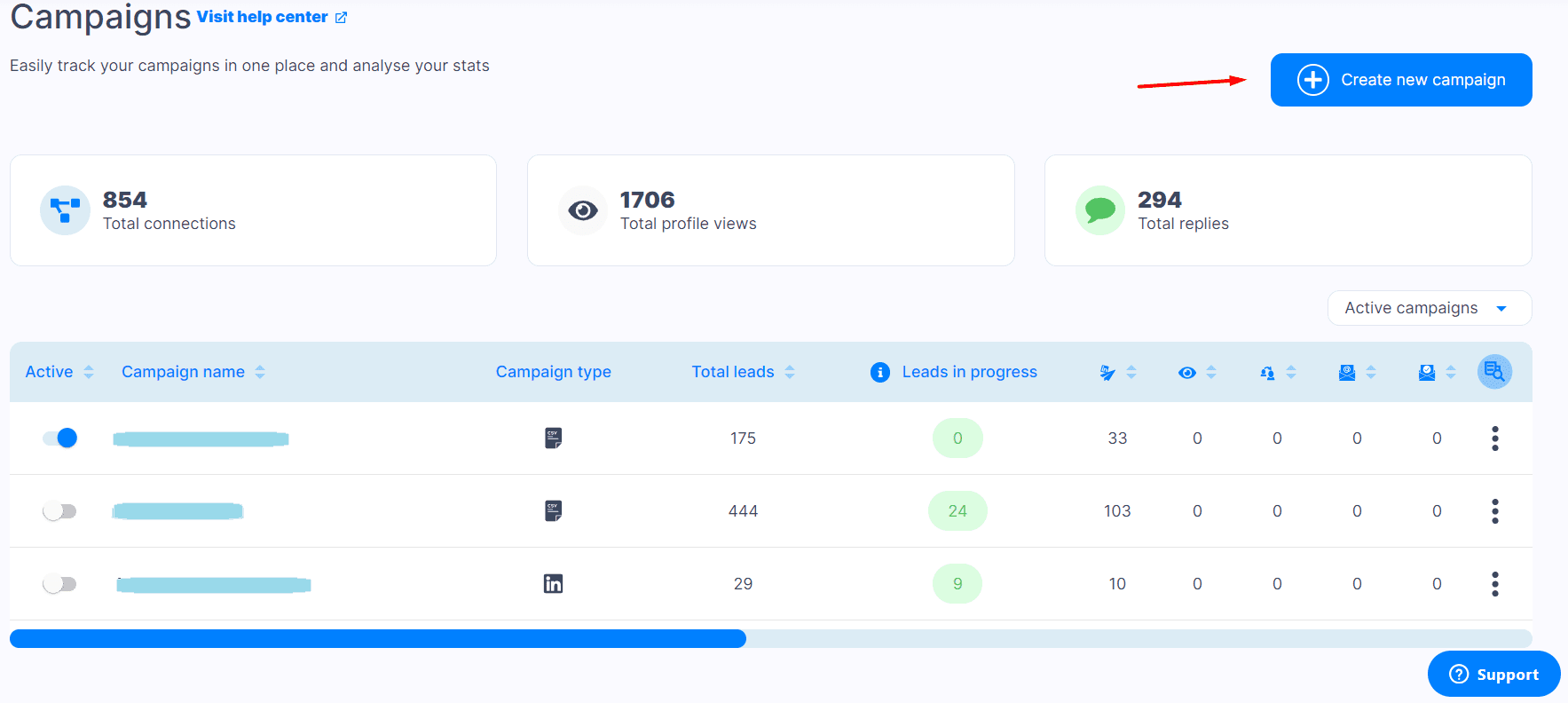
2. Name your campaign.
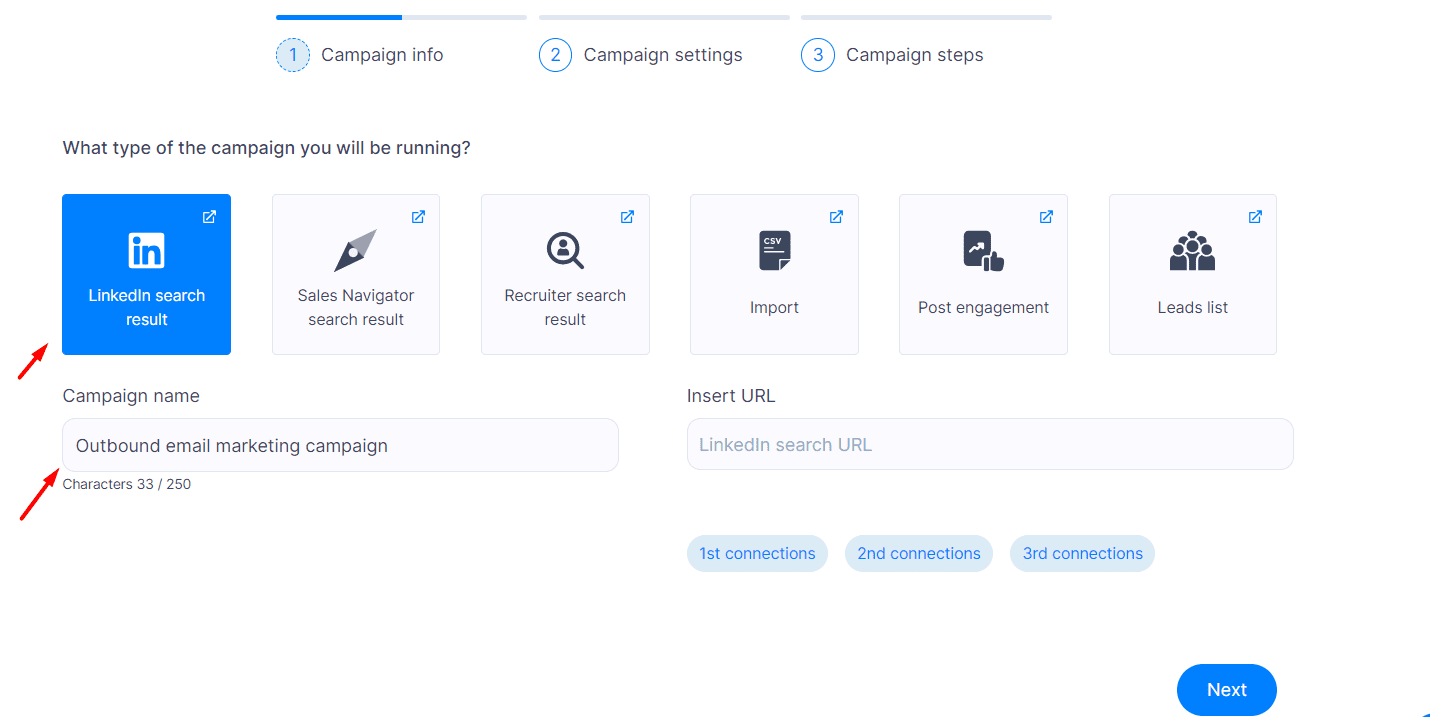
3. Paste a LinkedIn search URL, or add some other source out of six possible lead sources.
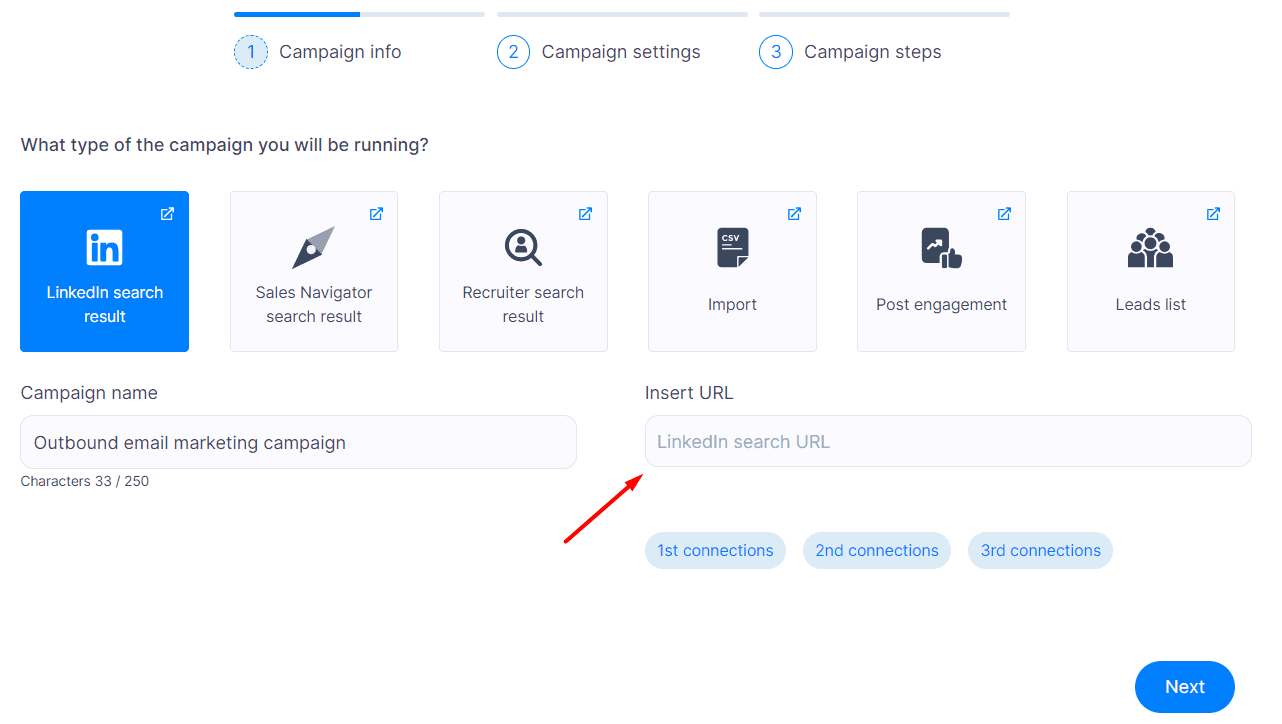
4. Adjust your campaign settings and click on “Create campaign.”
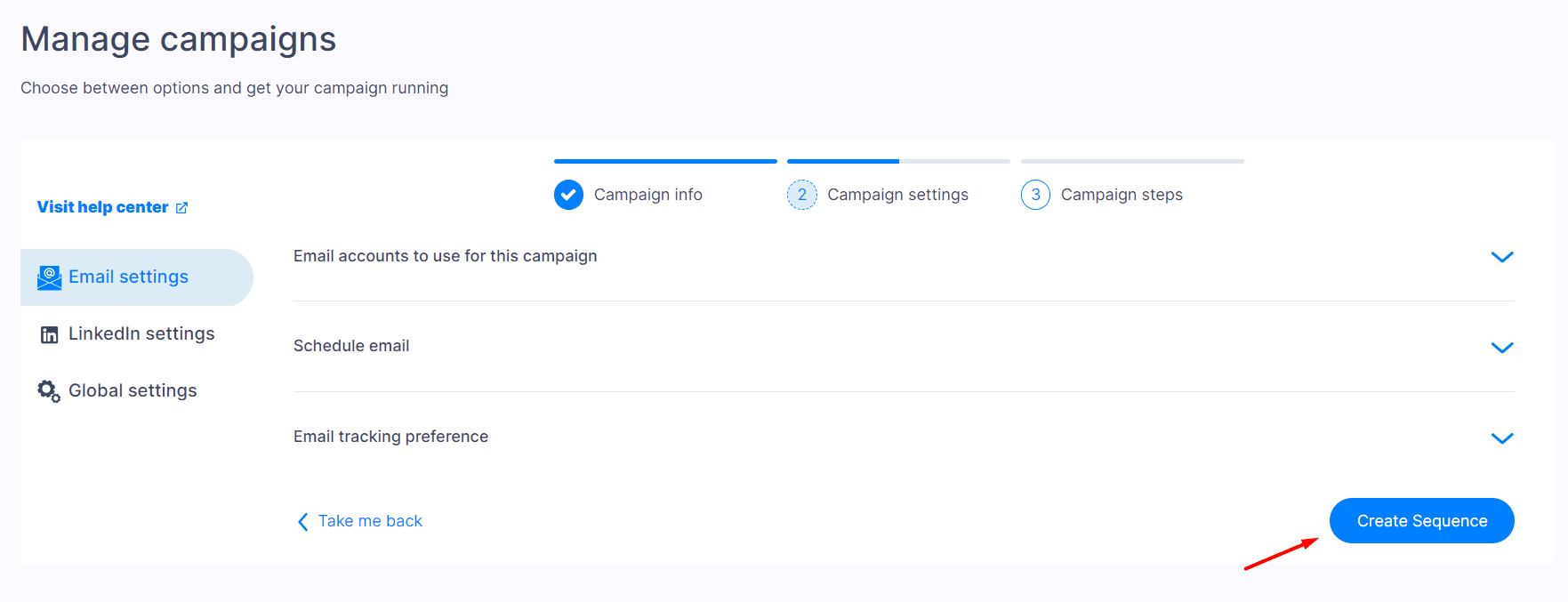
5. After you click on “Create campaign,” a popup will appear. You can choose one of two options. Click on the “From scratch” option.
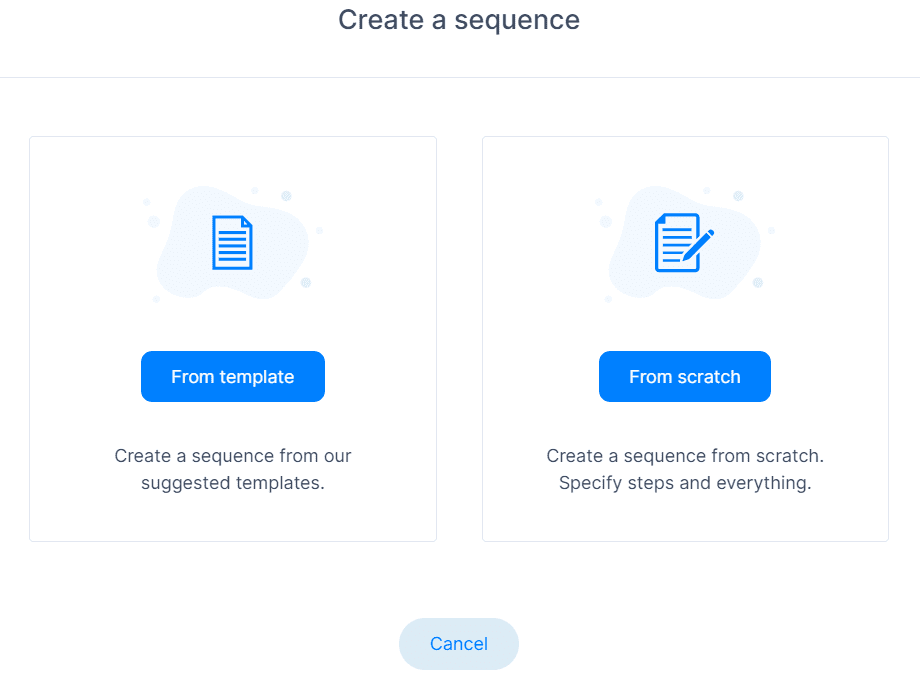
6. The next step is adding your campaign elements, actions and conditions to form your outbound campaign.
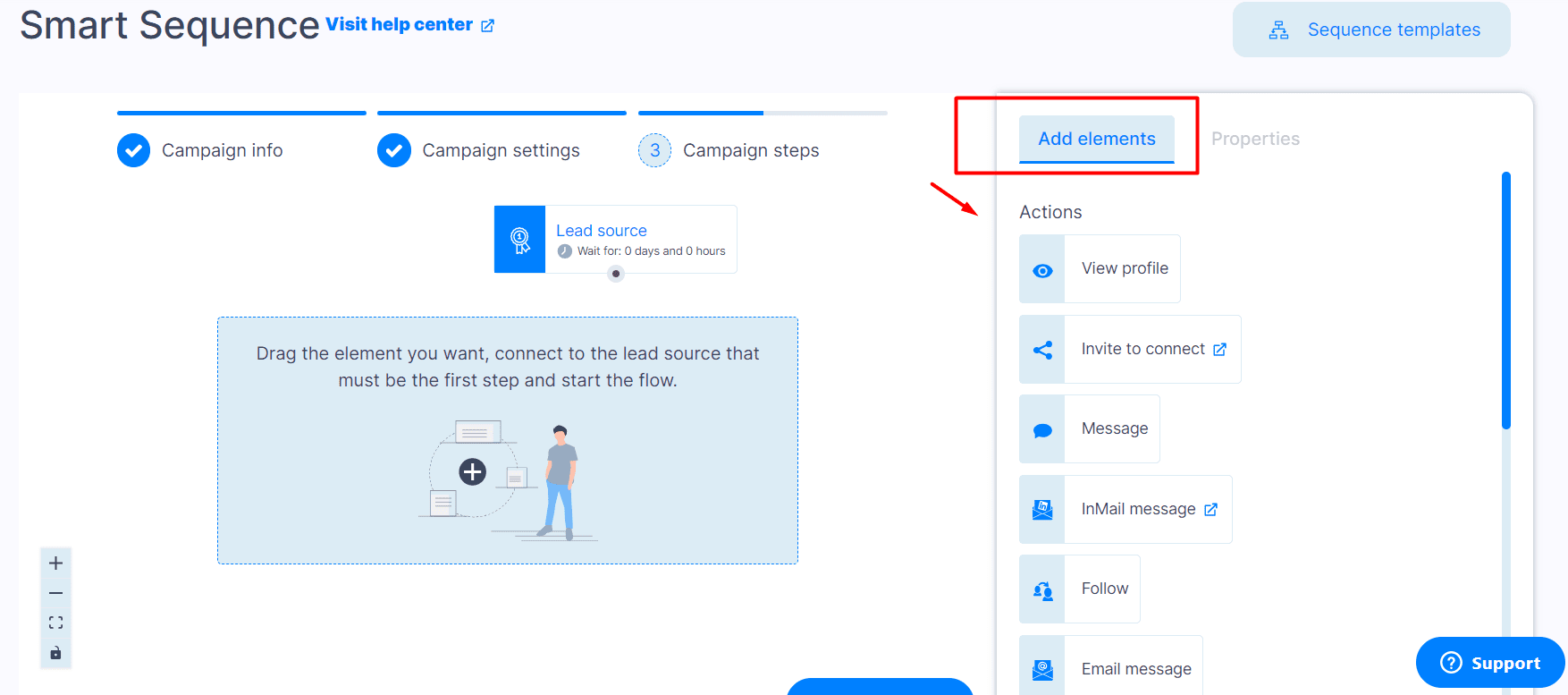
We’ve tested and perfected the following sequence as an example of a simple outbound outreach campaign. We believe that outbound outreach campaigns are far more effective when you use the multichannel approach. Therefore, this sequence combines email and LinkedIn outreach, with added email, LinkedIn message, and InMail examples for two different outbound campaign scenarios:
Open rate: 63%
Scenario #1: Content distribution or event promotion
If you want to get more eyes on your content or more sign-ups for events, these templates will be a perfect way to do so.
First email:
Subject: {{solutionToPainPoint}}: Exclusive {{typeOfContent/Event}} Inside
Hi {{firstName}},
Facing {{painPoint}} challenges? We've got a solution.
We’ve created a {{typeOfContent/Event}} to specifically address these issues.
Check out our {{content/EventName}} and get hands-on experience on how to achieve {{results}}.
Cheers,
{{yourName}}
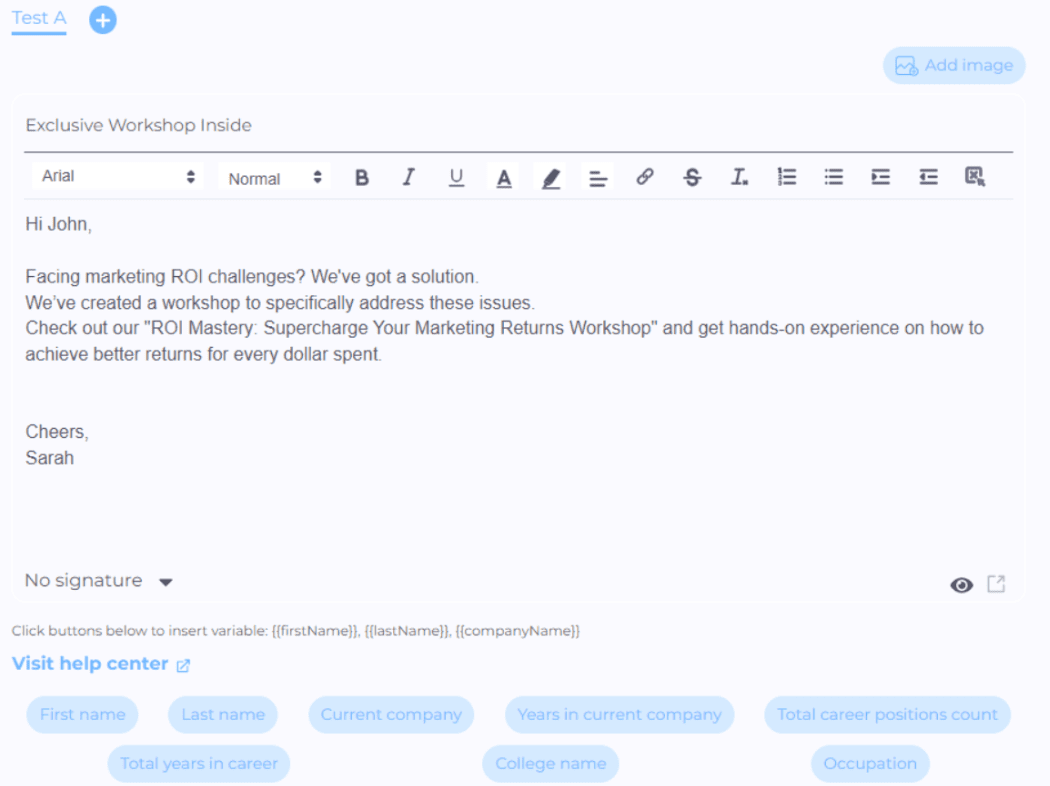
Follow-up email:
Subject: Missed Our {{typeOfContent/Event}} on {{painPoint}}?
Hi {{firstName}},
Just checking in about our exclusive {{typeOfContent/Event}}. It's tailored to help you achieve {{results}} by addressing {{painPoint}}.
Does this {{typeOfContent}} resonate with you? We would love to hear your thoughts.
Best,
{{yourName}}
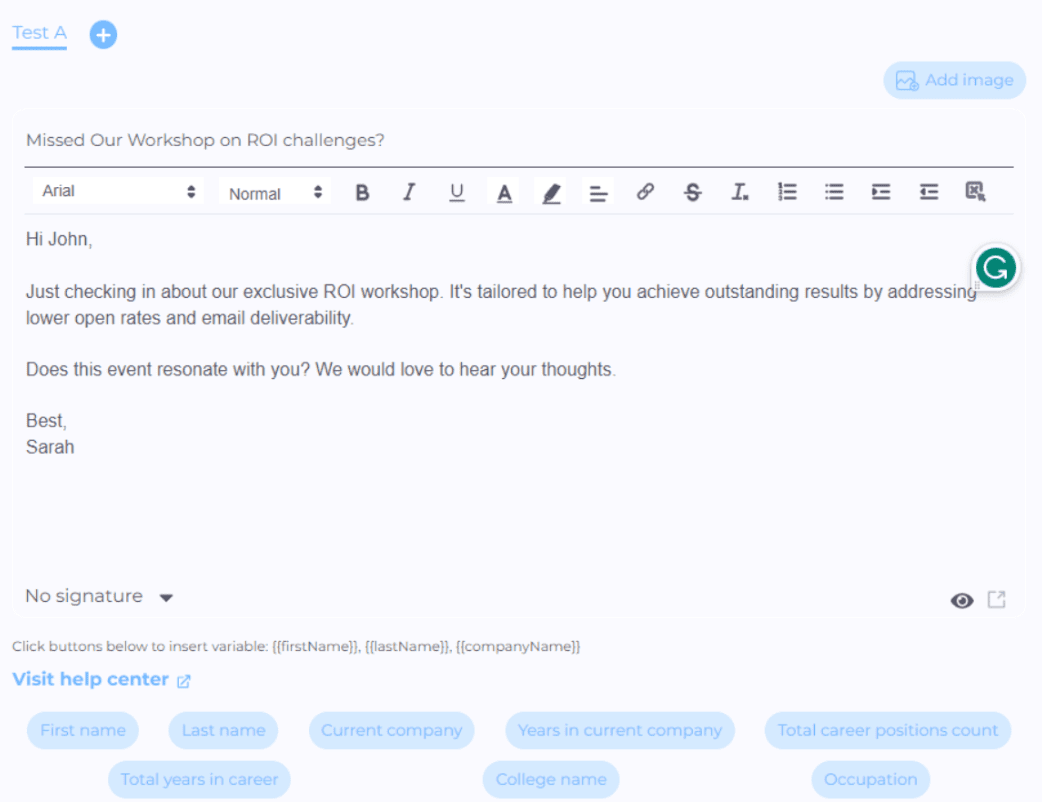
LinkedIn invite to connect message:
Hi {{firstName}},
Your work in {{specificField}} caught my eye. We’ve created something that will turn the tables on {{painPoint}}. I think you'd find it very useful and inspiring, so I wanted to reach out and connect on it.
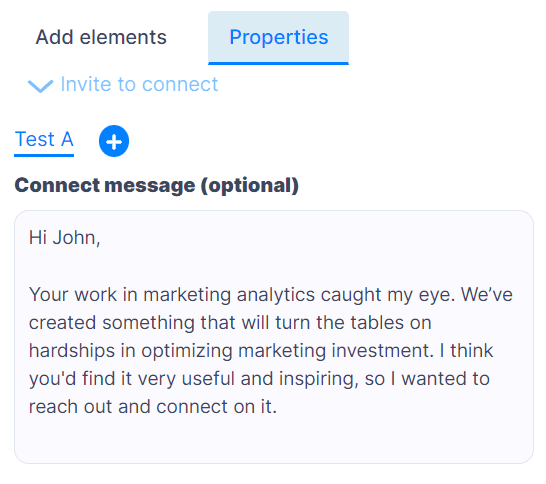
LinkedIn message:
Hi {{firstName}},
Thanks for accepting my invite. Here’s a link to {{content/EventName}}, which focuses on {{painPoint}}. I really think you, as a {{occupation}}, will benefit from it.
Please let me know if this hits the spot.
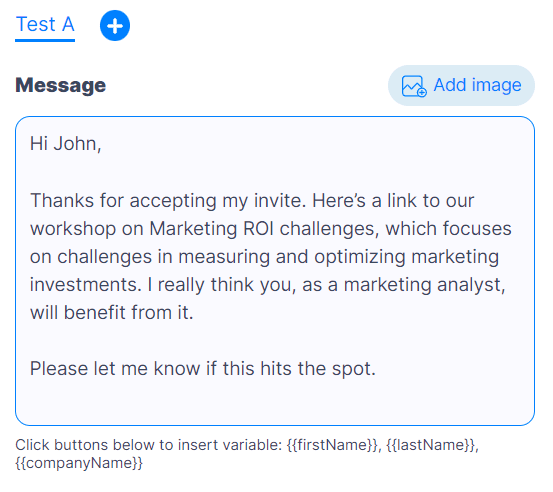
InMail message:
Subject: Let's Tackle {{pain point}} Together!
Hi {{Recipient Name}},
Noticed we missed connecting earlier, but your expertise in {{specific field/interest}} truly stands out. I wanted to reach out to share {{content/event name}}, aimed at {{pain point}}. Considering your background, I think it's perfect for you.
Does this hit the spot for you, as a {{occupation}}? I would really love to hear your thoughts on it.
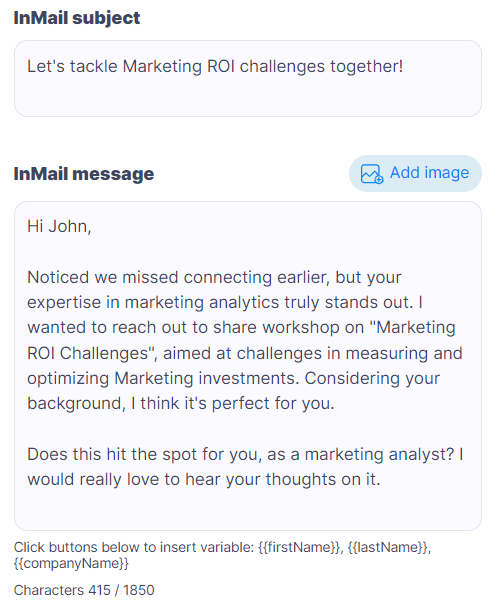
Scenario #2: Product promotion
If you’re a lead generation manager, these templates might come in handy.
First email:
Subject: Get {{results}} With This Tailored Solution
Hi {{firstName}},
I've been following your posts on LinkedIn because they talk about {{specificField/Interest}}, which I always love to see myself. Without taking too much of your time, I would like to showcase a product, {{productName}}, that reminded me of some of the challenges and topics you've discussed. It offers a unique approach to {{painPoint}}
I thought it might resonate with you. Mind if we jump on a call and talk more about it?
Warmly,
{{yourName}}
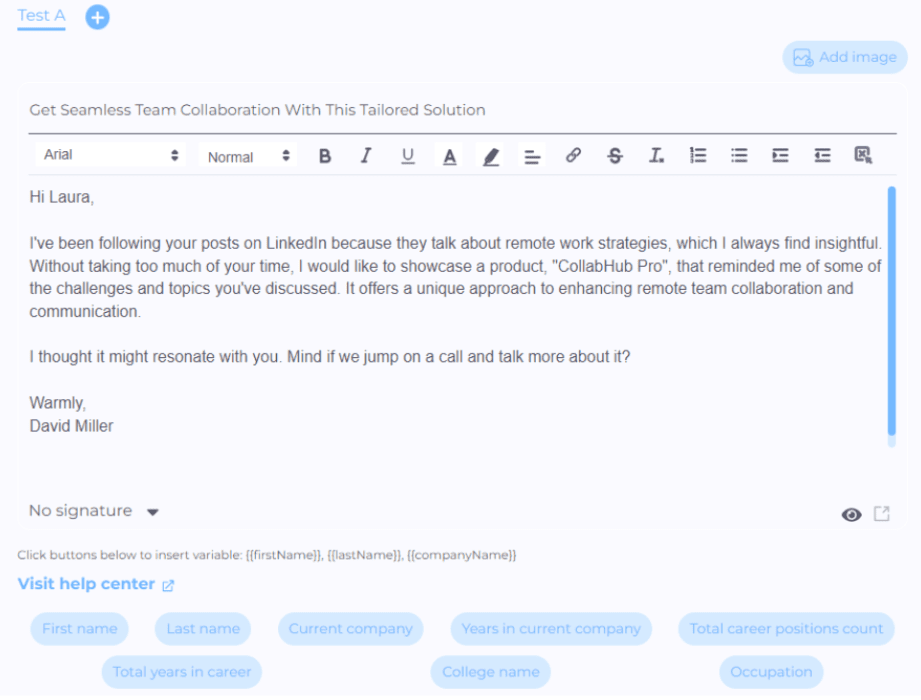
Follow-up email:
Subject: {{productName}}: A Fit for Your {{occupation}} Workflow?
Hi {{firstName}},
Revisiting our chat about {{productName}} – its features seem to align well with your work in {{specificField/Interest}}. To be more specific, with {{productName}} you can:
- {{benefit}}
- {{benefit}}
- {{benefit}}
How about it? Would you like to jump on a call, so I can get to know your precise workflow and create a tailor-made strategy that you can use to reach {{results}}.
Best,
{{yourName}}
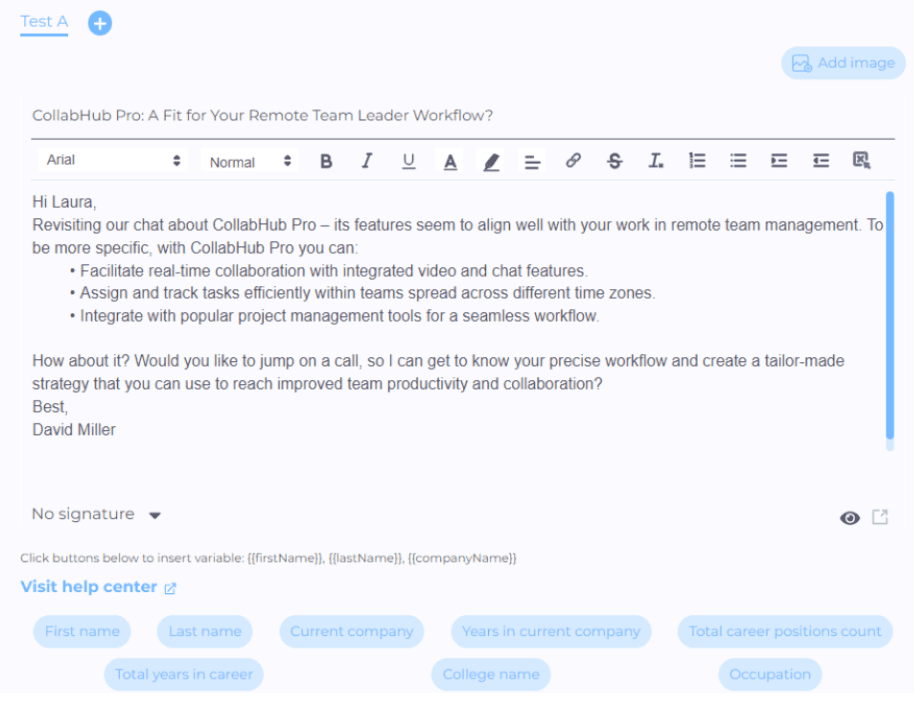
LinkedIn invite to connect message:
Hi {{firstName}},
I was blown away by your posts on {{topic}}! As I also share your passion for {{topic}}, I wanted to connect and exchange our experiences.
Perhaps there is a potential for a collab.
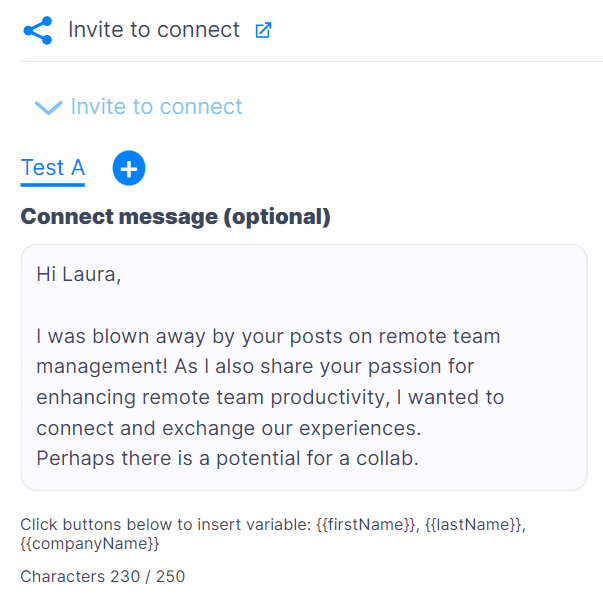
LinkedIn message:
Hi {{firstName}},
Thanks for linking up! Your forward-thinking approach with {{topic}} sparked a thought - what would you say if I told you that {{productName}} can help with {{painPoint}} and deliver results?
Would you be up for a quick chat about it?
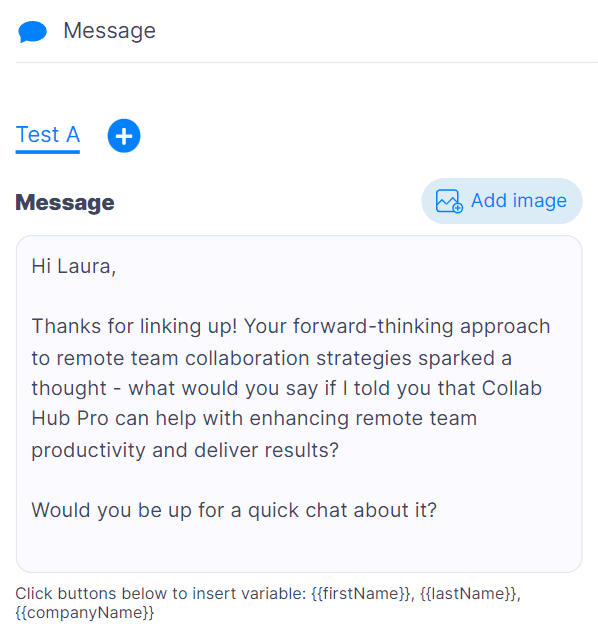
InMail message:
Subject: Let’s Speed Up Your Workflow With {{productName}}
Hi {{firstName}},
I noticed we hadn’t had a chance to connect earlier. Your amazing post on {{topic}} really stands out from the crowd. It got me thinking about {{productName}}, which seems tailor-made for {{painPoint}} that you’ve highlighted in your post. With {{productName}}, you can:
- {{benefit}}
- {{benefit}}
- {{benefit}}
I would really love to chat about it since I believe you can greatly benefit from it.
Let me know when you’re available so we can discuss the potential.
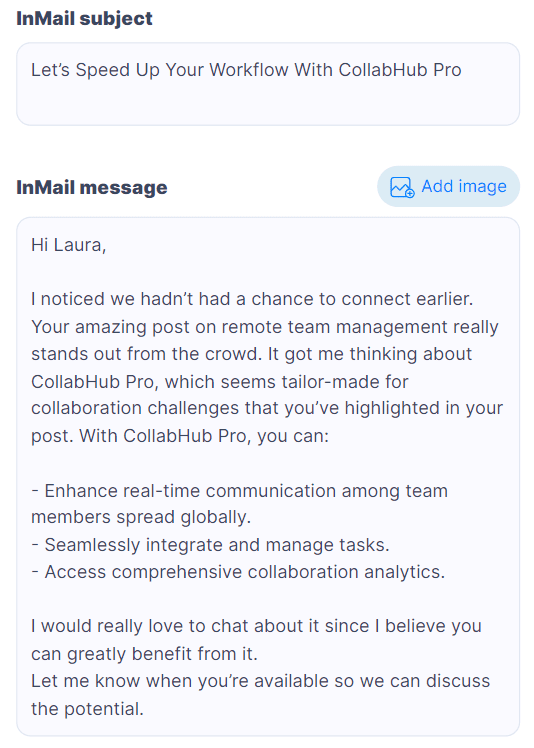
Frequently asked questions
Is cold email outbound marketing?
Yes. Sending cold emails is the foundation of outbound marketing. When done right, it could help with brand awareness or bring traffic to your website. It can even act as a lead magnet, thus being one of the most powerful channels of outbound marketing.
How can one effectively measure and optimize the performance of outbound email campaigns to improve future strategies?
To effectively measure and optimize outbound email campaigns, focus on metrics like open rates, click-through rates, and conversion rates. Utilize A/B testing for subject lines, content, and send times to refine your approach based on data-driven insights.
Are there specific examples of how outbound email marketing has significantly impacted business growth or lead conversion rates?
Outbound email marketing can significantly impact business growth by nurturing leads into customers and enhancing brand awareness. Specific case studies highlight increased lead conversion rates and ROI when personalized, targeted email strategies are employed.
What are the most common challenges businesses face when starting with outbound email marketing, and how can they address these challenges effectively?
Common challenges in outbound email marketing include ensuring high deliverability, maintaining GDPR compliance, and crafting engaging content. Addressing these challenges involves using reliable email marketing tools, staying updated on email regulations, and continuously testing and adapting email content strategies.
What are 3 advantages of outbound marketing?
With outbound marketing, you can reach a wider audience but also use strategic targeting to narrow down prospects, find a niche, and enhance your results. Finally, you can get faster outreach results if you contact your prospects at the right time and with the right call to action.
What are the advantages and disadvantages of outbound marketing?
While you can reach more prospects with emails and target your niche well, there are some disadvantages to outbound marketing. Cold outreach could damage your reputation: people tend not to trust emails from unknown senders. Additionally, outbound marketing costs more, depending on the outreach size and the tool you use.
How effective is outbound marketing?
Very effective. If we know that 99% of email users check their inboxes every day, we know that your prospects will surely see your email. It’s up to you to make the content stand out and underline the importance of your CTA, turning a cold into a warm lead.
Is it OK to cold email companies?
No. However, if companies comply with regulations, sending cold emails is legal. Nonetheless, if they do not opt in, you may risk damaging your company’s reputation by sending unsolicited emails. Ultimately, this practice might lead to recipients marking your emails as spam or simply unsubscribing from all future communication.
Conclusion
The immense potential of outbound email marketing is what kept you going through this article to this very point. If your goal is to reach more leads faster, grow your audience, and build brand awareness, then outbound email marketing is your best tactic.
From years of experimenting and testing it out ourselves, we’ve managed to grow our own company and establish Skylead as one of the leading automation tools out there. If we could do it with our own tool, imagine what you can do with it.
Not thinking a cold email opening line through can cost you a response, a call, or a scheduled demo.
The most common mistake rookies make is to invest time into coming up with a catchy subject line and then fail miserably once the email is opened. What makes a sales rep a top-notch performer is the ability to write attention-grabbing email introductions and to structure their writing in a way that is compelling enough to keep you reading all the way through.
When writing an email opening line, keep in mind that you have around 6 seconds to capture the interest of someone you’ve never met in person. This time shortens for a busy decision-maker. Long story short, you don’t have words to waste. Therefore, start strong.
Since lots of people are struggling particularly with email introductions, we’ve decided to write a short guide on how to write genuinely personalized email opening lines that catch your lead’s attention, make them want to keep reading, and finally, make them wish to respond.
By the end of this blog, you’ll learn:
- Why your email opening line matters;
- How to safeguard your domain and prevent high bounce rates;
- 6 most common mistakes when writing email opening lines;
- 12 email opening line templates for 12 outreach scenarios.
Let’s get started!
Why your email opening line matters
Cold emails can be used for pretty much anything - getting that perfect job or landing a really good deal for your business.
So, even if you’re not a sales rep, selling is a crucial part of our everyday lives. We sell our knowledge, our expertise, our point of view, face-to-face or in writing. However, cold emailing is a specific task and its success depends on various factors.
- How well you targeted and researched your lead;
- How relevant and to-the-point your personalization is;
- If your subject line made your lead curious enough to open the email;
- If your email opening line was compelling enough to keep them interested in reading more;
- Whether you included some kind of a hook;
- If there’s a call to action, etc.
When it comes to email opening lines, their purpose is to build rapport with your lead and to convince them to keep reading. Such an important task for such a short paragraph, isn’t it? But the rules of sales have changed, and not much can we do about it. Relevance and personalization became a straightway to success, and the sooner you abide by the new rules, the faster you’ll begin to see the results.
However, before we move onto the email opening line templates, let’s quickly go through several important points when sending cold emails that could potentially compromise the effort you’ve put in writing a good email sales copy.
Business email verification: Safeguard your domain
Many resources talk about how to find your lead’s business email addresses, as it’s obviously a minimum requirement for cold emailing. However, the second minimum requirement for cold outreach to be anywhere successful are emails being delivered. Despite this, not many mention the importance of email verification and how skipping this step could seriously harm your domain in the long run.
Namely, high bounce rates are one of the top reasons, alongside excessive volume and consistency, complaint rate, and being blacklisted by too many users, for poor email deliverability. High bounce rates represent the percentage of email addresses that didn’t receive your message because it was invalid and therefore returned by a recipient’s mail server. The more times this happens, the higher the chances are for your emails to end in a spam folder instead of the primary Inbox.
While you can solve the above threats by investing time into planning your outreach and making every email matter, there is only one way to lower your bounce rates - and that is to use Sales Engagement Platforms such as Skylead that find and verify business emails for you. In case a business email address is not verified, the platform won’t send the email as it may affect your domain health.
If you’ve never used a Sales Engagement Platform of this kind, check how Skylead assures higher email delivery rates.
6 most common mistakes when writing email opening lines
- You start your email with Hi, my name is;
- Your email is not straight-and-to-the-point from the start;
- Your email introduction talks about how “amazing” you or your company is;
- You opened your email in a generic way;
- There’s no name or last name of the person you are writing to;
- Your email opening line is too long.
12 email opening line templates for 12 outreach scenarios
#1 Connect after you’ve met in person
Template
Hello {{firstName}},
It was really nice chatting with you at {{eventName}} {{timeOfTheEvent}}. I found your point of view on {{topic}} interesting and decided to get in touch with you personally.
[...]
Example
Hello Anna,
It was really nice chatting with you at the 2022 Marketing Trends & Predictions event last Tuesday! I found your point of view on the development of social media marketing for small businesses interesting and decided to get in touch with you personally. [...]
This email opening line works because it specifies right away where you met and what you spoke about. The more precise you are, the more you show that you listened and that you genuinely cared for what someone had to say. Additionally, the tone is friendly, casual, and complimenting. Use this email introduction to connect and network or develop the conversation in the sales direction.
#2 Reach out to a content creator on LinkedIn
Template
Hello {{firstName}},
{{time}} I came across your LinkedIn post on {{topic}} that helped {{lead’sEndResult}}. I have been following you and your content on LinkedIn, and I must tell you that applying your advice {{yourEndResult}}.
Example
Hello Jerry,
A month ago I came across your LinkedIn post on objection handling that helped your Sales Team scale LeadUp by 30% in revenue in just 3 months! I have been following you and your content on LinkedIn, and I must tell you that applying your advice increased my conversion rate by 10%.
[...]
This email opening line works because it shows that you are truly following their content, that you admire their work, and that the lead’s advice was valuable for you too. Use this email introduction to offer a solution that your lead could benefit from or that is complementary to the lead’s business. This approach will do just perfect for your LinkedIn lead generation message, as well.
#3 Investigate on the solution that your lead’s already using
Template
Greetings {{firstName}},
I saw that your company is using {{solution}} for your {{purpose}}, is that correct? I hope you don’t mind me reaching out directly, just wanted to ask you if you could change one thing about {{solution}}, what would it be?
Example
Greetings Martha!
I saw that your company is using GetResponse for your newsletter automation, is that correct? I hope you don’t mind me reaching out directly, just wanted to ask you if you could change one thing about GetResponse, what would it be?
[...]
This email opening line works because it shows you’ve done your research and are reaching out to your lead with facts and concrete reasons. Furthermore, you are not trying to pitch your solution right off the bat, but are investigating customer satisfaction first and building rapport. Use this email introduction to offer your solution that has the competitor’s weakness as a unique selling point.
#4 Use your lead’s review as a reference
Template
Hello {{firstName}},
I saw that you recently reviewed {{lead’sProduct}} on {{reviewWebsite}} and expressed concerned regarding their {{concern}}. I know how frustrating that situation can be, so I wanted to take a moment and introduce {{yourProduct}} that might solve that problem for you.
Example
Hey Jasmine,
I saw that you recently reviewed PopBy on Capterra and expressed concerns regarding their customer support. I know how frustrating that situation can be, so I wanted to take a moment and introduce Meety that might solve that problem for you.
[...]
This email opening line works because you are reaching out to your lead with a verified pain point they are experiencing. You want to see if they would be interested in hearing more about your product because it would directly solve the issue they expressed in the review.
#5 Reach to an attendee of your event/LinkedIn event
Template
Hello {{firstName}},
It was great seeing you at {{eventName}}. I just wanted to thank you personally for participating and ask if you found the event useful for {{company}} and the {{industry}} industry in general. If yes, I have something that might interest you!
[...]
Example
Hello Ross,
It was great seeing you at the Social Selling Strategy For Medium-Sized Businesses Event. I just wanted to thank you personally for participating and ask if you found the event useful for TransFly and the transportation industry in general. If yes, I have something that might interest you!
[...]
To clarify, this email opening line works because it states in detail the event that the lead attended, the company they work for, and their industry. Moreover, it indicates that you did your research and want to offer a solution that might specifically help their business/industry.
#6 Ask a question to pitch a solution
Template
Hello {{firstName}},
I came across your LinkedIn profile as I was researching {{occupation}}. I just wanted to ask {{question}}.
Example
Hello Steve,
I came across your LinkedIn profile as I was researching SEO & Web Content Specialists. I decided to contact you directly as I am curious to know if you’ve ever got valuable results in less than 20min when researching keywords and keyword synonyms?
[...]
This email opening line works because it shows you researched your lead before reaching out to them. You know their niche and the niche’s pain point/rooms for improvement, and you might have a solution that could help them save time and improve their service/product.
#7 Email a lead that commented a post on LinkedIn (or anywhere else)
Template
Hello {{firstName}},
I am writing to you regarding your comment on {{user’sName}} LinkedIn post. I wanted to send a resource that might help you understand {{painPointLeadExpressed}}. If this clarifies a bit the issue you mentioned in the comment, there’s more where that came from!
Example
Hello Jane,
I am writing to you regarding your comment on Josh Duane’s LinkedIn post. I wanted to send a resource that might help you understand where and when to use personalized GIFs and Images, and how to make them. If this clarifies a bit the issue you mentioned in the comment, there’s more where that came from!
[...]
This email opening line works because you are reaching out to your lead with the intent to help them. Additionally, you are offering a resource to solve a problem or issue they expressed in the comment of someone’s LinkedIn post (or anywhere else). Use this email introduction to later pitch your product that has this feature in particular, for example.
#8 Make a reference to a mutual connection (potential collaboration)
Template
Hello {{firstName}},
{{mutualConnection}} from {{company}} spoke highly of you and your professional achievements, your {{achievement}} in particular! That’s why I decided to directly reach out and speak about a potential collaboration.
Example
Hello Jenna,
Marta Jamerson from FlyHigh spoke highly of you and your professional achievements, your development of Sales Techniques for smaller Sales Teams in particular! That’s why I decided to directly reach out and speak about a potential collaboration.
[...]
This email opening line works because mentioning a mutual connection right away is a smart move. It gives you certain credit and whoever sees a familiar name will most likely keep reading. Furthermore, it shows that you know what the lead is doing, what their achievements are, and that those are the ones you are writing them for.
#9 Give value and then offer your service
Template
Hello {{firstName}},
I came across your {{product}} the other day while researching {{solutions}} and immediately spotted a few things that you can change to {{endGoal}} (déformation professionnelle, hehe, sorry!). This tip might help you see this side of your business in a new light.
[...]
Example
Hello Tiphany,
I came across your website the other day while researching Marketing Automation Tools and immediately spotted a few things that you can change to improve your visitor’s experience (déformation professionnelle, hehe, sorry!). This tip might help you see this side of your business in a new light.
[...]
This email opening line works because you are giving value (free gift) to your potential customer even if they don’t decide to hire you for the above service. Use this email introduction to hook your service and show the quality of your work.
#10 Follow up after a cold call
Template
Hello {{firstName}},
Great talking to you today! As promised, I am sending you a quick summary of the topics we covered over the phone this morning.
Example
Hello Kate,
Great talking to you today! As promised, I am sending you a quick summary of the topics we covered over the phone this morning.
[...]
This email opening line is an excellent reminder even if the cold call didn’t go the way you wanted to (and even if it did). This is your second chance to interest your lead into knowing more or you can investigate deeper on their pain points and rooms for improvement.
#11 Create a need to pitch your product
Template
Hello {{firstName}},
When was the last time {{company}} {{yourService}}?
Did you know that -
{{whyLead’sWayIsNotGoodForBusiness}}
What if we changed things up a bit?
Example
Hello Anthony,
When was the last time EightUp organized a team-building event that was more than food and drinks after work hours?
Did you know that -
- 75% of employees find team buildings of this kind useless, draining, and forced to attend?
- Only 10% of employees claim that they actually bonded with someone from another department during the team building of this kind?
- 83% of employees wish they could learn more from team buildings and actually bond with colleagues that are higher up the hierarchy?
What if we changed things up a bit?
[...]
This email opening line works because it shows concrete statistics that the lead’s way of doing certain things is not productive (or maybe even counterproductive). Moreover, you can offer a 180° turn to the way they are doing business.
#12 Reach out to a churned user
Template
Hello {{firstName}},
I have exciting news for you! {{yourCompany}} now has a {{upgrade}}, which allows you to {{benefit}}. Let me briefly present all of its advantages.
Example
Hello Angela,
I have exciting news for you! Skylead now has a native Image and Gif personalization feature, which allows you to include personalized GIFs and Images into your outreach routine with just a few clicks. Let me briefly present all of its advantages.
[...]
This email opening line works in case you reach out to a churned user. It lets them know that now you have something that they named as the reason to stop using your product. It's always good to reach out and try to re-sell them the improved version of your product from the start.
Frequently asked questions
How to personalize these templates for different industries without losing the initial impact?
For personalizing templates across industries, focus on customizing your approach. To do this, weave in sector-specific language and referencing current industry trends or news. This ensures relevance and maintains the original's engaging effect while speaking directly to the recipient's interests and challenges.
How to establish the balance between humor and professionalism in cold emails to maintain credibility?
Balancing humor and professionalism requires a nuanced approach. In other words, consider your audience's industry culture and tailor your humor to be light and relevant to your message. Aim for humor that enhances, rather than undermines, the professional quality of your email, ensuring it's appropriate and adds value.
How to form follow-up strategies when an initial email with a catchy opening line doesn't receive a response?
When a catchy opening line doesn't prompt a response, develop your follow-up email strategy by offering new information or value. Highlight a different aspect of your proposal or share a recent success story related to their industry. This approach can re-engage their interest and demonstrate persistence without being pushy.
Summary
The hardest part of any important task is getting started in the first place, isn’t it?
Now, we gave you 12 email opening line templates to get through to your leads from the very first email.
Use these templates as they are or as an inspiration for your own scenarios.
Additionally, what also worked for our Sales Team was combining these email introductions with personalized GIFs and Images and sending them out to leads found by prospecting on LinkedIn. This practice skyrocketed their reply rates and, to be honest, also did the ability to write good follow-ups after no response.
And in case you are searching for a solution that will find and verify business emails for you, has a native feature for personalizing GIFs and Images (and includes them into your emails with just one click), and that can speed up your outreach process by 60%, sign up for Skylead's 7-day free trial and see it for yourself how much we rock!
Creating the perfect call to action (CTA) for your email can be tough. It can ruin your outreach efforts or skyrocket your conversion.
In other words, if your call to action isn’t compelling, clear enough, or doesn’t resonate with the overall email message, it will go over your prospect’s head. As a result, your lead won’t perform the desired action, and you will lose that lead or have to work twice as hard to convert them.
Thus, in this article, we are diving deep into the meaning and importance of CTAs in emails and showing you how to craft a perfect CTA. In addition, we will provide you with the call to action examples that you can use as inspiration for your outreach.
What is a call to action?
A call to action (CTA in short) is a phrase that serves as a directive for target groups or leads to perform the desired action.
As a motif used for sales and marketing efforts, a call to action usually shows up in the ads, emails, websites, and other types of content geared towards the target group. For example, you’ve probably seen the following phrases in the ads a thousand times by now:
- Watch;
- Shop Now;
- Buy;
- Download, etc.
Yup, those are all CTAs.
Now, a call to action can manifest in distinct forms, such as:
- A button on a landing page or ad;
- Hyperlinked text on a landing page or email;
- Long, plain text, often found in an email;
- As a short sentence that acts as a preface to another call to action.
A perfect call to action helps you capture leads, directly influences and improves conversion, and drives other desired actions depending on the goal.
However, if we talk about B2B sales emails, crafting the call to action is more complicated than B2C. Why? Because you cannot just link the word Buy at the end of the email and expect people to... Well, buy it. In other words, you need to take an entire buying experience (longer than B2C one), sales funnel, and your message into consideration.
And yes, catchy email subject lines and attention-grabbing opening lines will help you increase the open rate and get your emails to be read. Still, a call to action combined with a well-crafted message will directly impact your desired action.
Email call to action types
Before jumping into actionable tips that you can use to craft the call to action for your email, let’s first look at what email call to action types are at your disposal. Instead of analyzing B2C CTAs, we will focus only on B2B calls to action that salespeople can use in emails.
1. Sign up
This call to action type serves as a little nudge. It is often used for Freemium services, so leads can understand what the product is all about. The good news is that this type of action doesn’t cost a person anything, and it is easier to achieve than a demanding conversion, such as starting a subscription.
2. Resource
Using this CTA, you are offering your potential clients the resource you think they will benefit from the most. In addition, the resource is often free, and if you get them to open your email and if you hit the right pain point with your message, you can expect a high resource visit rate.
3. Discovery
From time to time, you will need to send more information about your product/service. Luckily, you, a well-skilled salesperson, already have a special landing page that your trusted marketing team created for you that you can send out.
4. Schedule a meeting/demo
This is a type of CTA that you can use after the lead has responded to your cold outreach.
5. Free trial
Responding to this call to action, leads will have the opportunity to test out your product or a service, before deciding whether or not you wish to commit.
6. Subscription started
After the leads have tested your product, you will try to nurture them to start the subscription. In this case, you will use said CTA.
7. Follow-up
This Call To Action type serves as a reminder to the prospect they didn’t respond to your email or didn’t do the necessary action.
8. Review
If you wish to ask your customers to leave a review on a listing website, you will use this CTA.
9. Event promotion
Using this call to action, you can gather attendees for the upcoming special event, such as webinars, training, courses and gatherings.
Call to action (CTA) performance metrics
Crafting and using the right Call To Action in your emails can be effective. However, how would you know if the certain CTA actually worked and brought you the results? Why, with your trusted metrics, of course.
In addition, depending on the type of conversion you wish to get, the metrics will differ. Thus, here is a table with metrics corresponding to the call to the action type.
| CTA Type: | Metrics: |
| Sign up | Number of signups; Signup rate per month |
| Resource | Number of reads/views |
| Discovery | Number of landing pages visits |
| Schedule A meeting/Demo | Number of meetings scheduled and held per month |
| Free Trial | Number of Free Trials started |
| Subscription Started | Number of subscriptions started, LTV, Churn rate |
| Follow up | Response rate |
| Review | Number of reviews given |
| Event Promotion | Number of attendees per event |
Finally, do not forget to use UTM parameters in your emails for the metrics that include website data.
Tips to create call to action
Like CTA in marketing, Calls To Action in sales emails need more thinking through, as well. In other words, they need to be easy on the eyes, clear, comfortable for the prospects to say yes to, and much more. Thus, here are the tips that will help you craft the best CTAs in emails that work.
1. Email message and call to action in synergy
We cannot talk about Call To Action and not mention your entire email message. Email messages and CTAs go hand in hand, and you cannot expect one to work without the other. After all, your email needs to help your prospect accomplish their goal or solve the problem.
So, you need to specify the pain point or goal you wish to address. Once defined, only then start crafting your CTA accordingly.
Example:
Let’s say you wish to book a meeting with the prospect and share how your service can help them precisely. Thus, your email and CTA can go something like this:
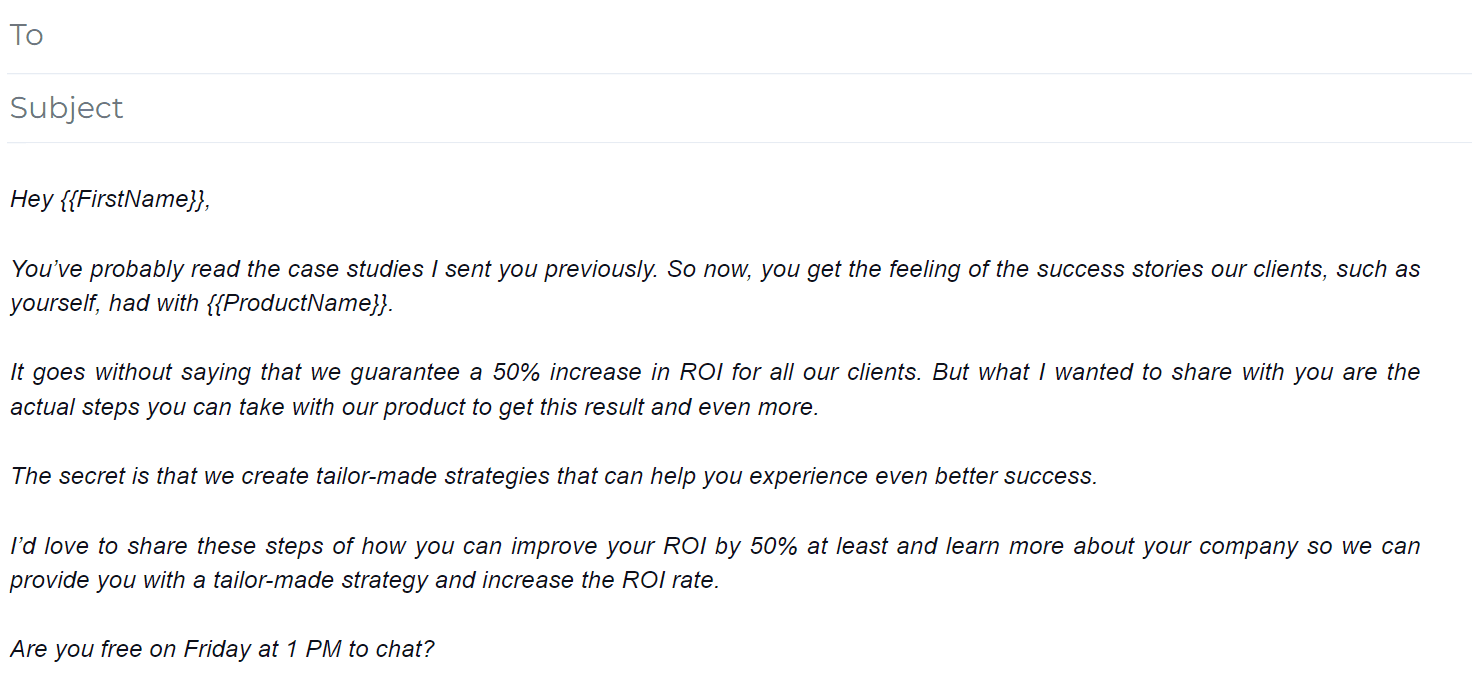
So don’t be the one who cannot see the forest from the trees and expect your CTA alone to work. Define your pain point message, and work on your Call To Action so they match.
Additional tip: You should always write your email message around your CTA. Let's say, for example, the idea is to book a meeting. Then you should write the email that gives the reason to the prospect to take that call.
2. Write call to action as a part of conversation
While we are still on the subject of an email message and CTA synergy, let’s glance at the previous example one more time.
Do you notice that we didn’t use a Call To Action such as Book A Meeting at the end of the email? Standard CTAs that you can find on landing pages or ads do not work well in sales emails as they create a sense of abruption in communication.
So we created Call To Action as a seamless part of communication. The reason is that these CTAs note better performance in sales emails. Why? The answer to this question is because of the social selling principles.
3. CTAs that are easy to say yes to
Sometimes getting the conversion is tough, and prospects often feel that you ask too much of them. This happens if we talk about conversions, such as starting a free trial or service subscription, in particular. So, the objective is to always craft your Call To Action as defined as possible.
Examples:
a. Does Thursday at 2 PM work for you?
b. Can you give me the contact information of a person who I can talk to about…?
c. If you are interested, just respond with “Yes” and I will send you the free audit of your business.
4. Use one clear call to action per email
Nowadays, we have a lot on our minds, and we process a large amount of information per day. So naturally, our attention span got shorter over the years. This goes with your prospects as well.
Thus, when writing an email, use only one Call To Action. Using multiple CTAs is one of the biggest email mistakes and can confuse your prospects. In addition, it can make them unaware of the next step and cost you the desired conversion.
5. The power of words
If, for example, we say I love your work, or I like your work, which one do you think is more effective? You are right - the first one is. You see, words alone bear meanings that can impact us emotionally and mentally. Therefore, choosing the spot-on words for your CTA can really make a difference in how your prospects feel.
So, to make your Call To Action more impactful, choose more uplifting words. In addition, always read your CTA and check how you feel afterward, as this way, you will get a sense of how your prospects will feel. Here are a couple of examples.
| Instead… | Use This. |
| Read how our clients managed to… | See how others in your position managed… |
| Join our webinar to learn about… | Seize the opportunity to pump up your SDR skills with our webinar. Join us! |
| If you are interested to… | If your answer is “Yes, I want it!”... |
6. Use first-person POV when possible
Personalization is everything when it comes to sales and marketing. If you are already personalizing your email outreach with variables such as name, occupation, or custom introduction, you might as well do it with your CTAs. Still unsure? Here is our leverage:
Company ContentVerve experienced a 90% increase in click-through rate by using the first-person point of view. They managed to do it by using the phrasing “Start MY free 30-day trial” instead of “Start YOUR free 30-day trial” *.
The reason why first-person point of view works is that your prospect will receive more personalized communication and will feel more connected to your brand.
7. A/B test your call to action
A/B testing is the only proof of outreach effectiveness, whether we talk about subject lines, messages, or opening lines. Thus, naturally, testing applies to the Call To Action as well.
In addition, if you use a sales engagement tool, such as Skylead, you can set up your email outreach testing as easily as 1, 2, and 3. Simply add your sequence steps, and message variants.
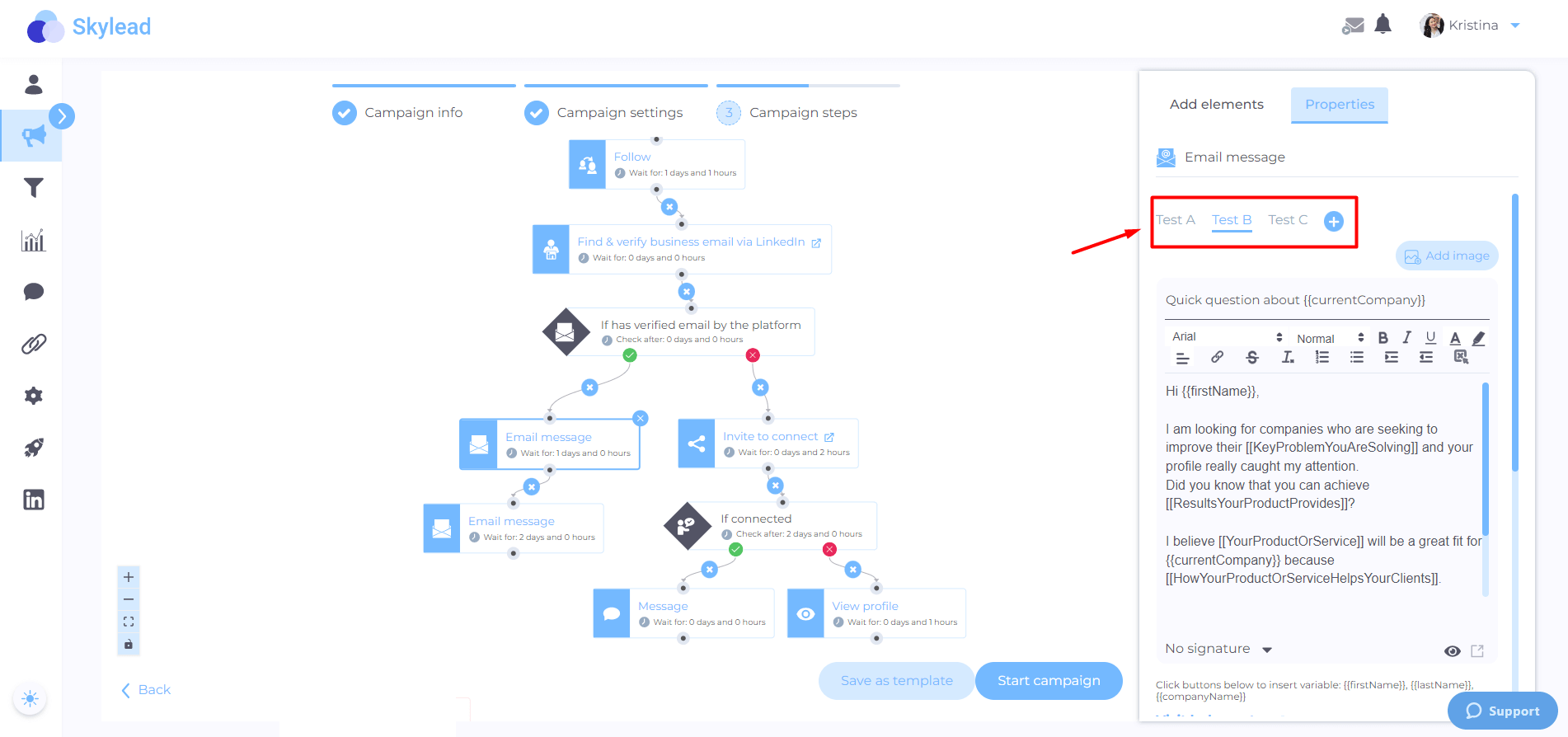
Once you launch the campaign and results start coming in, you'll see the step-by-step analytics showing which variant worked best.
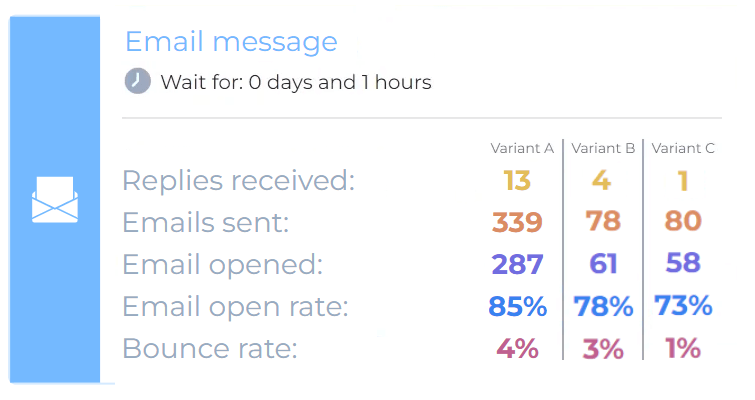
Extra call to action examples
Now that you know how to craft your perfect Call To Action, let’s go over additional examples and reasons they work.
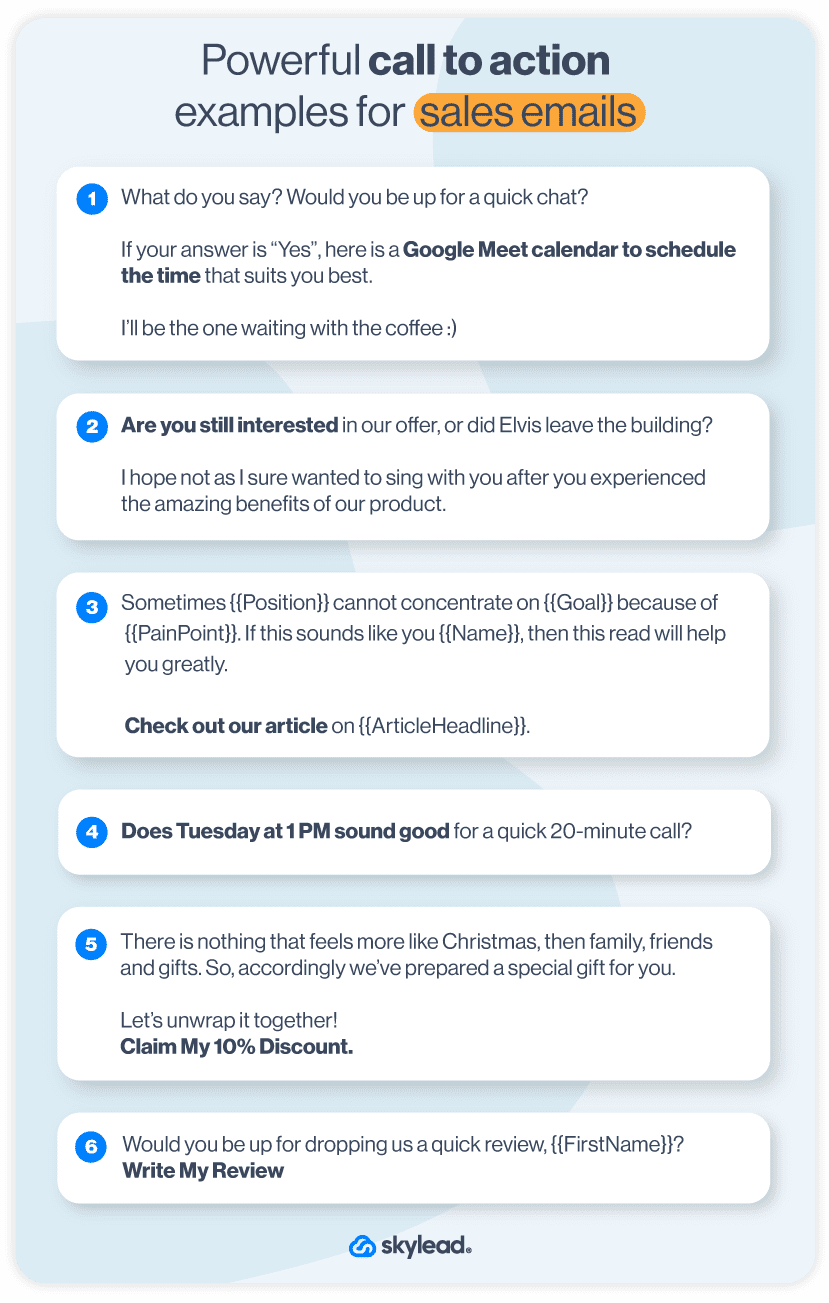
The one with the calendar
“What do you say? Would you be up for a quick chat? If your answer is “Yes”, here is a link to schedule the time that suits you best. I’ll be the one waiting with the coffee :)”
So, we have a couple of benefits here. Firstly, this type of call to action is an easy win since your prospects are one click away from scheduling a call when it suits them most. Secondly, the other perk is that there is no back and forth communication if either party is not available at the other one’s proposed date. Lastly, speaking of “the words that have power’ implying the answer, such as Yes, will give a more positive connotation to the email.
As mentioned before, just be sure to give them a valid reason why they need to take the meeting, so by the time they reach your Call To Action, they will actually wish to take the meeting with you.
Additional tip: This CTA simply calls for a personalized image or a GIF at the end of an email. In other words, you can place your image holding a coffee cup with your lead’s name on it.
Stir the CTA pot with a pinch of the theme
Everybody loves when they notice a specific theme woven into the email that is tailor-made just for them. Hence, the best way you can do it is to find the idiom or a topic and build your Call To Action around it.
As an example, here is our idea for salespeople:
"Are you still interested in our offer, or did Elvis leave the building? I hope not, as I sure want to sing with you after you experience the amazing benefits of our product."
In addition, this particular Call To Action can be a good idea for the follow-up when the prospects haven't responded yet, and belong in the Free Trial or Subscription pipeline stage.
Call to action examples that offers empathy
Sometimes prospects may not know what exactly they are looking for unless you point it out. By describing the actual pain point and offering a solution immediately, you show your prospects that you are here to help.
Here are the two CTA variations you can use to share a resource or schedule a call.
a. Sometimes sales people cannot concentrate on closing the deals because of spending too much time manually searching for the prospects.
If this is you, then this read will help you greatly.
Check out our article on 3 things you should automate in your outreach.
b. Sometimes sales people cannot concentrate on closing the deals because of spending too much time manually searching for the prospects.
If this resonated with you Debbie, then, we need to talk. I can share a couple of tips you can apply to reduce manual work.
Does Wednesday at noon work for you?
Short and precise call to action example
If for some reason, you do not have a meeting scheduler, this CTA is for you. It is short and detailed since it offers the exact date and time.
I’d love to hop on a meeting and chat about how we can work together. Does Tuesday at 1 PM sound good for a quick 20-minute call?
Specifying the exact CTA with time and date is always a win. However, there are two extra cherries on top of this CTA cake. Firstly, you show that you care about your partnership.
Secondly, there is any indication, a promise if you will, of how long the meeting will last. In other words, everyone likes short calls, especially the decision-makers. Also, if the future meeting lasts longer than 15 minutes, well then, things are looking up to close that deal.
Checking the status CTA
If you wish to throw a ball in your prospect’s courtyard, you can do so by asking them what is the next step on their behalf. As opposed to asking whether they will do something, you are asking them what they are going to do. Here are the examples:
a. Will your next action be {{Action}}? Or did I get that wrong? Just wanted to check if there is anything else I can help you with.
b. I wish to make the process super easy for you. Is there anything I can do so you can fully make the transition to our product?
By responding, the prospects keep you in the loop, and the conversation will move on. Furthermore, this example is the perfect idea for figuring out what stops them from starting the subscription process. In addition, this can be an example of the conversation-starting CTA as a part of the follow up email after you received no response.
Value exchange call to action example
If, for example, you have churned customers or the leads that never converted, you might want to think about offering a limited-time discount. In this case, you can use CTA such as:
Nothing feels more like Christmas than family, friends, and gifts. So, accordingly, we’ve prepared a special gift for you. Let’s unwrap it together. 👉 Claim My 10% Discount
This Call To Action is motivating for a couple of reasons. Yes, you are offering a discount which can be alluring, but you are also personalizing with a first-person point of view. In addition, by choosing the word Claim and implying friendship, you show that something belongs to them. And it won’t take long until they take it.
Furthermore, you can create a similar Call To Action if you wish to ask your customers to write a review for your website or leave it on a listing website. It can go, for example, like this:
We value your opinion, and it would be amazing to hear your voice in the form of a review.
As a small gesture for your effort, we have prepared a $25 Amazon gift card that you can spend on your friends and family.
What do you say?
Would you be up for it? 👉 Write My Review
In conclusion
It is important to look at your Call To Action as a part of the bigger picture. For example, the composition of still life entirely depends on beautifully painted fruits, flowers, and glasses. Thus the effectiveness of the entire email is decided by its subject, opening line, message, and CTA and can influence your overall lead generation. When perfectly crafted together, conversion is imminent.
Once you understand this, you can easily follow the tips for writing the perfect Call To Action:
- Write Email messages and Call To Action in synergy;
- Weave CTA as part of the conversation;
- Create Call To Action that is easy to say Yes to;
- Use one and clear Call To Action;
- Choose your words in CTA carefully;
- Use the first-person point of view where possible;
- A/B test everything.
With these tips and examples mentioned above, your Call To Action will point out what is the most important to your prospects. In addition, your CTA will give your prospects the reason for conversion.
Now, go ahead and create your amazing CTAs!
P.S. Wish to automate your LinkedIn prospecting, activities of generating leads on LinkedIn, or use multichannel outreach? Drop by and try out Skylead for free!
What would you say is the first thing that catches your prospects' attention in their inbox? That is right, email subject lines. They are undoubtedly the most integral part of your cold email outreach. In just seconds, the faith of your outreach success is determined.
How? Well, if you do not create catchy email subject lines, you risk getting your email deleted, your open rate becomes much lower, and you will be disregarded as Spam. Consequently, this ultimately leads to a lower number of warmed-up leads and closed deals. Furthermore, effort and time spent will go to waste.
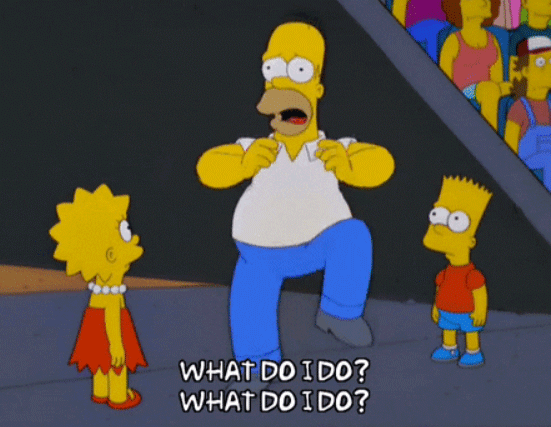
Don’t panic. We’ve got your back.
In this article, we are explaining what the subject line is and why it is important for your email outreach. Furthermore, we are digging deep into catchy email subject examples, why they work, and help you create your golden subject line that catches your prospects’ attention immediately.
What is an email subject line and why is it important?
Let’s start with the basics. When you open up email inbox, you can notice the 3 following components of the email message:
- Senders’ name,
- Subject Line,
- And Preview text.
Email subject line is a text line next to the sender’s name, describing the title of the email message. In other words, it is an indication of what the message is about and why you should read it.

Email subject line communicates value, sets expectations, and entices recipients to discover more about the topic by reading the email message.
Getting your email subject line just right will make you stand out in the sea of other emails and increase the open rate. In sales terms, this means increasing the chances of getting your message across and warming up leads so you can close more deals.
Another thing worth mentioning is the importance of the Preview Text.

A preview text, aka preheader text, is a line next to the subject line that shows the beginning of your email message. In some cases, preview text can be custom-made if you use newsletter software or similar tools, but in most cases, it shows a preview of your message. That is why it is important to perceive them in synergy rather than separate components to make your outreach as effective as you can (but we will talk more about this below).
How to write catchy email subject lines: Tips to get started
Email subject lines’ first and foremost purpose is to get your prospects to open up your email. In other words, you need to catch their attention and entice them towards this action.
Therefore, make email subject lines mean something. Let’s go through a couple of steps to get started.
1. Determine the type of subject lines
As a salesperson, especially when doing a cold outreach, your job is to set the tone of the email subject lines. There are many ways to do it - making bold, sweet, or commanding statements - but first, you need to figure out the email content. After that, write down the email core meaning, and choose the type of tone which best fits your outreach message, personality, and prospects’ preferences.
The usual subject line types for sales are:
| Email Subject Lines Types | Email Subject Lines Examples |
| Controversial | LinkedIn is not for outreach if… |
| Lack | Poor quality data costs you. Here’s why… |
| Personalized | Amy, this tip will improve your business |
| FOMO (Fear Of Missing Out) | Catch limited time offer |
| Guide | How to close deals in 3 days |
| Questioning | What is your top priority? |
| Sneak peek | A discount gift for you |
| Making an offer | 10% off lifetime offer |
| Statistics | 92% of salespeople swear by this strategy |
| Directive | Use this fantastic tip to improve sales |
| Pain point | If you struggle with wasting time, use this hack |
2. Straight to the point
Be clear and concise about your email subject lines whenever you can. The reason is that often prospects prioritize the emails by their subject line and order of reading/replying. For this reason, the email subject line should communicate what the message is all about and its importance.
Avoid vague subject lines, such as “While I wait for your response”, that doesn't show anything about the email content as it will end up at the bottom of the priority list, and prospects will eventually forget it.
However, this doesn’t mean you can’t get crafty with it. You can create wordplay such as “Let’s Taco ‘bout your performance”, create a theme as “Let’s schedule a coffee chat”, or even use the power words to enhance your catchy email subject lines.
3. Power words in email subject lines
Specific words can trigger an emotion in us on a conscious or subconscious level. Let's take the word “happy” for instance. After reading it, you suddenly felt a slight uplift in your mood, didn’t you? What happens with the word “Sad”? You felt slightly down there, correct?
Words are indeed powerful. So using specific words in subject lines can do the same for your prospect. To be more precise, using Power words can really catch your prospects’ attention and activate an emotion. Furthermore, if you put the Power word at the subject line beginning, it will draw even more attention.
Here are power words example list to catch your prospects’ attention and get them to open up your email:
| Providing value: - Inspire - Learn - Guide - Enjoy - Proven - Lifetime - Discount - Valuable - Nifty - Secret | Pain point focus: - Ready - Change - Save - Stop - Avoid - Easier - Faster - Improve - Skyrocket - Reach |
Note: The important thing is to set expectations with power words, but be careful not to overpromise, as this will only annoy your prospects. And do not go overboard with them.
4. How long should email subject lines be
On average, email subject lines should ideally be 4 to 7 words. If you need more words, aim for a subject line no longer than 9 words, which is the upper limit. Furthermore, contemporary inboxes can reveal up to 60 characters on average, depending on the email provider.
Also, keep in mind that some people check their emails on mobile devices, which show only 41 to 50 characters. This roughly translates to 7 to 8 words. Therefore, to lower the number of characters, you need to remove any filler words, such as just, hi, thanks, going to, etc.
Note: If you plan to reach out to your prospects using LinkedIn InMail, you should know that the subject line character limit is 200 characters. Check out our complete guide on how LinkedIn InMail works and 13 InMail templates for a better response rate.
5. Use subject lines and preview texts in synergy
As we mentioned earlier, the preview text is a line of text found next to the subject line. It shows the first couple of words of your email message. In addition, it can show custom text if you use a newsletter software tool.
Preview text is just as important as the subject line - it is your chance to deepen the message and make it more effective to get your prospects to open up an email.
Preview text is usually 35 to 90 characters long, depending on the email provider. To make a subject line and preview text work together, it is best to perceive a preview text as a collection of details that didn’t fit the subject line. Here is an example:
Subject line: 🎁 A discount gift for you
Preview text: Happy Women’s Day! Up until the end of March, you get a discount of […]
Note: To convince a prospect to keep on reading the email and perform the desired action, make sure you get your opening paragraph and a Call To Action right.
Email subject lines best practices [and some worst ones to keep away]
Now that we’ve set the email subject lines basic steps, let’s go through the best practices and what you need to avoid.
Subject lines best practices
1. Personalization
Did you know that personalizing subject lines can increase the open rate by 22.2%? The increase in open rate happens because personalization creates a sense of familiarity in leads. Especially if you found those leads by prospecting on LinkedIn. Furthermore, it comes across as genuine and that you care for them.
Personalize your email subject lines using the following demographic, psychographic, and firmographic data:
- Interaction with your brand
- Their location
- Years in the company
- Current company
- Interests and values
To gain a full understanding of how powerful personalization in outreach can be, check out our blogs on how to increase the level of personalization in outreach and how to personalize image and GIF to improve response rate.
2. Use emojis In email subject line
In modern days times, emojis can be a nifty tool to spice up your subject line. They are a friend in need to get your point across, make your email stand out in the inbox, and they cost only one character (speaking of saving the space in the subject line :).
To back this up, take a look at the following statistics:
Emojis in subject lines had an open rate of 56% higher than those without them.
Not bad, ha 🧐?
3. Include numbers
Catchy email subject lines that include numbers achieve 45% higher open rates. This way, prospects will perceive your subject line as more precise and attract their attention. Use numbers to state how many tips you send them, time stamps, or statistics to increase the value.
4. Email subject lines specifying time
Providing your prospects with the right information that is in correlation with time will attract their attention as it represents information that is a “current trend”. Nicely timed subject line will increase an open rate, as well as response rate depending on the email body.
Example:
Here is how to boost your April’s website performance
5. Hint the valuable content
One of the perfect ways to increase the open rate is to give your prospects a sneak peek into the body of the email. This catchy email subject lines’ teaser can be in the form of content that prospects will value, such as images, infographics, and guides with top 5 tips.
Example:
Why Sales Needs To Get Out There And Use Social Selling More (Webinar)
6. Subject line testing
You need to test your email subject lines to be sure you got them just right, and there are a couple of ways you can do it.
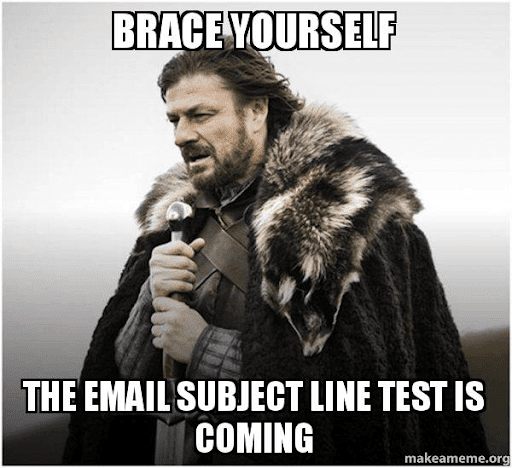
A/B testing
Every audience is different, and in some cases, one subject line that worked previously won’t be that effective anymore. And then, there is the following fact:
A/B testing can increase email open rates by 49%.
That is why you need A/B tests as much as possible. In order to do this, take 3 to 5 subject lines and send out those cold outreach emails to check which one has the highest open rate.
For example, in Skylead, you can test different subject lines for your outreach campaigns on autopilot and see which one works best for you.
Online email subject line testers
Online email subject line testers are nifty tools to have at hand if you are not sure about the effectiveness of your subject lines. Whether you wish to test the emotional tone of voice or the overall effectiveness of your subject lines, you can use tools such as Send Check It, EMV Headline Analyzer, or GradeMyEmail.
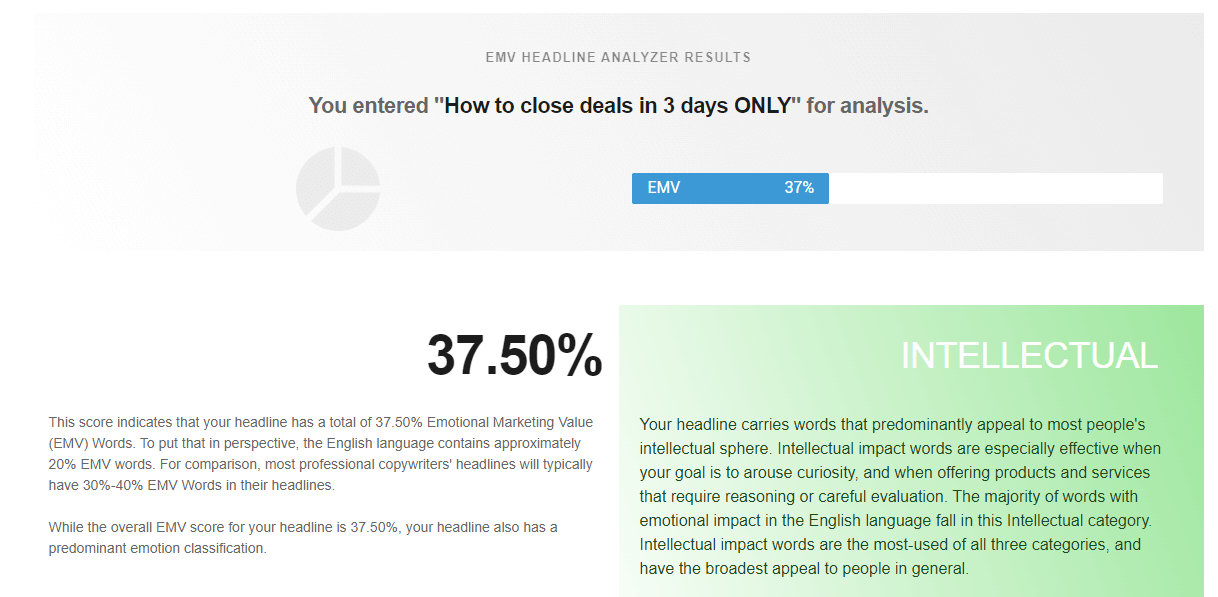
Email subject lines DON’Ts
1. Hi there
Avoid phrases such as Hi there, Greetings George, or Hello. The reason is they aren’t specific enough and do not show any hint of what the email message is all about. Instead, draw your prospect’s attention by clearly stating the purpose.
2. Misleading prospects
Being deceptive and promising your prospect one thing in the subject line and showing them another will annoy them. Consequently, you will lose trust and respect instantly. Not to mention, you will fail to close the deal with the prospect forever. Therefore, avoid click baits, or RE: and FWD: entirely just to get them to open up an email.
3. DO NOT USE ALL CAPS OR BUNCH OF EXCLAMATION POINTS!!!
See how that was unnerving and frenzy-like? Using letters in Caps Lock or with multiple exclamation points is a synonym for spammers these days. It also looks aggressive and distasteful, and you do not wish that for your brand, trust us. Furthermore, if you use this kind of email subject line, you risk getting your emails in the Spam folder. However, Caps Lock and exclamation points are not prohibited - you can always use one from time to time to emphasize your statement, but please do not go overboard.
4. Avoid spammy words
Similar to all-caps-lock words and multiple exclamation points, spam words can also ruin your outreach efforts. These words have been all over the internet for many, many years (not to mention billiards in the 80s) and are now considered repulsive and plain out pushy.
Here are a couple of examples to watch out for:
- Act Now
- Cash
- Cheap
- Credit
- Double your ROI
- Earn Extra cash
- Millionaires
- Free
- Fast money
- Get it today
Catchy email subject lines examples and templates
Follow up email subject lines
- Had a {{Topic}} idea for you since we last spoke
Example:
Had a social selling idea for you since we last spoke
- Been thinking about what you said
- Should I give up on you and close the file?
- I forgot to mention in our meeting that…
- The final and easy step…
- Tuesday meeting at 10PM
- Sending info I promised 👉
- I spoke with {{ReferredName}} and they said…
Example:
I spoke with Mark, and he said…
- Down to business - How we can help
- Need any help?
- {{firstName}} I need your advice
- Have 5 minutes for a quick call?
- I don't expect you to open this email but…
General cold outreach email subject lines
- ❤️ how you contribute to {{DesiredResult}}
Example:
❤️ how you contribute to closing the deals faster
- {{firstName}} let’s connect
- Are you completely happy with {{CompetitorName}}?
- Get lifetime access to {{SoftwareName}}
- What are your insights from {{Event}}?
- The most exciting opportunity for {{Industry}} companies in 2024
Example:
The most exciting opportunity for insurance companies in 2024
- Saw your amazing post - Interested in creating shared content?
- Exclusive for {{CompanyName}}: 3 tips to get conversion faster
- Congrats on {{Achievement}} 🥳
Example:
Congrats on becoming CEO 🥳
- Join forces? 👊
Urgent email subject lines
- Do you have these numbers and analytics yet?
- Hot conversion data insight for {{CurrentMonth}}, 2024
- Resource on {{Topic}} that’d go great in your {{Topic}} post
Example:
Resource on Email Statistics that’d go great in your Outreach post
- Omg {{firstName}}...
- It doesn’t look good
- 10 must-know trends to keep up on the market
- Your Free Trial is ending!
- Save 30% before the New Year
Email subject lines that entice curiosity
- Everyone’s favorite {{Occupation}} trick is…
Example:
Everyone’s favorite Sales trick is…
- 🤫 Real secret to {{Task}} or {{Benefit}} is…
Example:
🤫 Real secret to outperform outreach is…
- About your approach…
- I have a question about how {{DoingRelevantTask}}
Example:
I have a question about how you handle budgeting
- Does Thursday work for you?
- New year, a new strategy to {{Goal}}
Example:
New year, a new strategy to achieve 50+ conversions a month
- Are you taking advantage of your detailed reporting?
- How we accomplished {{DesiredResult}} in 2 months
Example:
How we accomplished 6x more sales in 2 month
- {{RelevantTopic}} trends that are the talk of the town
Example:
Sales strategy trends that are the talk of the town
- Save 5 hours a week with {{Task}} on autopilot
Example:
Save 5 hours a week with outreach on autopilot
- 56% of {{JobPosition}} use this trick to improve conversion
- A cheat-sheet for better conversion — Interested?
- {{Topic}} resources that can help you at this time
Example:
Cold outreach resources that can help you at this time
- 4 tips to help increase sales during hard times 💪
- It’s that simple 😃
- Few in the {{IndustryType}} know about these hacks
- Pick one out of these 2 strategies
Email subject lines that address pain points
- How to survive {{PainPoint}}
Example:
How to survive working 10 hours a day
- 5 easy steps to beat {{PainPoint}}
- How to deal with {{PainPoint}}
Example:
How to deal with LinkedIn algorithm
- 5 Ideas for {{PainPoint}}
- A resource to help you with {{PainPoint}}
- How happy are you with {{Department}} performance?
Example:
How happy are you with Sales performance?
- Steal this strategy from us - It will work for {{PainPoint}} 😁
- 7 tips for turning {{PainPoint}} around
- Proven solution to {{PainPoint}}
- Tired of {{PainPoint}}? Let’s have a chat
Subject lines that relieve pain and offer solution
- The fastest way to reach your Q2 target 💹
- Here is the shortcut to {{Benefit}} 🙌
Example:
Here is the shortcut to tracking performance easier 🙌
- Help is on the way - best strategies for LinkedIn lead generation
- Problem with closing the deals? Here is how to fix it easily
- Save up 5 hours of work per week
- {{ProductOrSolution}} empowers companies such as {{CompanyName}}
- Ready to implement {{Tool}} to eliminate {{PainPoint}}?
Example:
Ready to implement Skylead to eliminate wasting time on manual outreach?
Personalized email subject lines
- {{firstName}}, I was researching {{CompanyName}} and…
- {{ReferredName}} said to reach out to you…
Example:
Your colleague Steve said to reach out to you…
- {{ReferredName}} think you’ll love us too
- {{firstName}} I loved your post on LinkedIn about {{Topic}}
Example:
Sandy, I loved your post on LinkedIn about how to modernize sales
- Does this work for you {{firstName}}?
- {{firstName}}, a quick question regarding your performance
- {{firstName}}, I notice you try to achieve a 50% increase in sales
- Opportunity for {{CompanyName}}
- Partner up with {{CompanyName}}
- {{firstName}}, I have a story for you
- {{TheirCompetitorName}} VS {{CompanyName}}
- {{firstName}} perform {{Task}} better from Now on 💪
Example:
Andy perform outreach better from Now on 💪
- New managing employees strategy for {{CompanyName}}
- Loved the blog you wrote for {{CompanyName}}🔥
- {{firstName}} I missed you at {{Event}}
- What is your expert opinion on {{Topic}}, {{firstName}}?
Example:
What is your expert opinion on social selling, {{firstName}}?
- {{firstName}} is there a lot on your plate r/n?
Humorous email subject lines
- 🌮 Can we Taco ‘bout your growth?
- ⚽ I wondered why the ball was in my court, then it hit me
- I tried an elevator pitch - it was great on so many levels 🆙
- 🐝 You are likely an indecisive bee. Might I call you maybee?
- 🤝 Connect with you in present or future? It’s kinda tense
- 🪐 Should I organize a space for our meeting and planet?
- ⛵ Need a {{Topic}} strategy arc? I Noah guy.
Example:
⛵ Need a Sales strategy arc? I Noah guy.
- My coffee is mugged and waiting for your call 😅
- I'm gonna make him an offer you can't refuse…
- May the Force be with you, and {{YourCompanyName}}🌌
- {{ReferredName}} said to say hello to his little friend 🙋
- “You can’t handle the truth!” Or can you?
- Shaken, not stirred. 🍹 A {{Resource}} you asked for.
Example:
Shaken, not stirred. 🍹 A Guide To Outreach you asked for.
- I like {{ProductOrAService}} as my wine - sweet and victorious. Do you? 🍷
Frequently asked questions
How can one effectively A/B test different subject lines to find the most effective one for their audience?
A/B testing for email subject lines involves sending two variants to a small segment of your audience to see which performs better, then using the more successful one for the broader audience. Monitoring open rates for each variant provides actionable insights. You can automate A/B testing by using the LinkedIn automation tool and cold email software with such a feature, like Skylead.
Are there specific strategies for crafting subject lines that improve click-through rates, not just open rates?
To improve click-through rates, subject lines should create curiosity or offer value that compels the recipient to discover more inside the email. Personalization and urgency can also encourage clicks by making the email feel more relevant and time-sensitive to the reader.
How do the recommended subject lines perform across different industries, such as tech versus creative fields?
The performance of subject lines can vary by industry due to different audience expectations and content relevance. Customizing subject lines to reflect the specific interests and language of your target industry is crucial for maximizing engagement.
Summary
Strong and catchy email subject lines are mesmerizing and alluring to your prospects. They are links between your leads and your message. For this reason, it is important to make it as perfect as you can so you can increase the open rate, nurture the prospect and ultimately close the deal. And when you pass through the importance of it all, creating email subject lines and testing them can be fun indeed.
Here is a quick throwback of what you should and shouldn’t do when writing the email subject lines.
| Email Subject Lines DOs: | Email Subject Lines DON’Ts: |
| Use personalization | Avoid words such as Hi and Greetings |
| Make emojis your best friend | Do not mislead the prospects |
| Include numbers | Avoid words in Caps Lock |
| Make timely email subject lines | Remove excessive exclamation points |
| Hint the valuable content inside the email | Avoid symbols such as $$$ |
| Test your email subject lines | Forget about spammy words |
Now it’s your turn. Go and rock out those subject lines!
Wish to use Skylead for your outreach campaigns and A/B test your emails? We would be glad to hear from you and chat. Say hi by scheduling a Demo with us.
